Around an hour’s drive from Melbourne, the Yarra Valley is known as the oldest wine-producing region in Victoria, dating back to 1838. The region offers a diverse range of wines and is best known for its chardonnay and pinot noir varieties, favourites for producing sparkling wine.
As the name suggests, the Yarra Valley is named after Melbourne’s main river that begins its journey on the southern slopes of the Great Dividing Range and twists through the forested valleys of the Yarra Ranges and its quaint regional towns before flowing through Melbourne and concluding its journey in Port Phillip Bay. This pristine natural environment is home to breathtaking landscapes, beautiful native forests, is one of Melbourne’s main water catchment areas and currently hosts around 3,800 total hectares under vine. The Yarra Valley has an abundance of cellar doors and as a cool climate region offers some of the best sparkling wine at cellar door tastings and regional local produce at restaurants.
I grew up near here, on the other side of the ranges in St Andrews, which wasn’t then, but is now considered part of the Yarra Valley region. It always feels a bit like home when visiting, and with so many beautiful cellar doors showcasing the regions cool climate varieties, it is a lot more bubbly fun!
Although the first vines in Victoria were planted elsewhere, Yering Station in the Yarra Valley was the site of Victoria’s first commercial vineyard. It was planted by the Scottish-born Ryrie brothers in 1838, but it wasn’t until Paul de Castella took ownership that the first Yarra Valley wine was made in 1845. I remember this story from when I was a TAFE lecturer training tour guides. As one of the best day trips outside of Melbourne, the Yarra Valley was one of our training tours. The history is that after Paul de Castella took ownership, new vines were imported from France and production increased. It really was a ‘heyday’, establishing the area with international renown with wine awards won including the Grand Prix at the Universal Exhibition in Paris in 1889.
By the 1860s several other vineyards had been established in the Yarra Valley. A second de Castella brother, Hubert, planted St Hubert’s in 1863 and Guillaume de Pury established Yeringburg in 1864. Plantings reached nearly 1,000 acres by the turn of the century. As with a lot of wine regions the area was affected by the devastating insect pest phylloxera. The last vines from this era were uprooted in the 1920s and the land returned to pasture.
There was a small resurgence in the 1960s, with new vineyards planted including the re-establishment of Yeringburg and St Hubert’s. When I was growing up here in the 1980s, there were a few wineries, but the area was known more as a food bowl with fruit orchards and other crops. It wasn’t until 1989 that Victoria’s first commercial vineyard, Yering Station, was replanted, and that year was also the exciting release of the first cuvées for Domaine Chandon (now known just as Chandon). As part of an expansion and innovation strategy of the French Champagne House Moët en Chandon after establishing successful ventures in Argentina and California, they conducted an extensive nationwide search of wine growing regions and chose the Yarra Valley for their Australian sparkling operation in 1982.
The Yarra Valley now has more than eighty wineries, and because of its proximity to Melbourne, it is a popular tourist destination and home to some high-profile wineries and many smaller producers. Each winery expresses the diversity of its terroir, the passion of its producers, a mastery of traditional practices and despite its 170-year legacy, it’s far from old. It’s a hub for innovation and home to some of the most progressive, dynamic winemakers in the world.
With plenty of emerging varietal wines gaining popularity and prestige, there’s something for everyone in the Yarra Valley. It’s a popular day trip, but you could easily spend a few days here. There’s plenty of food and wine things to do, as well as family activities and nature experiences for a day out.
I suggest that you have a designated driver for your Cellar Door visits. To really relax and have a nice day out, it is much better to book a driver or book a day with a tour company. There are many to choose from for a day trip, from personalised small groups to larger coaches. You can find details on the Visit Yarra Valley website here.
While this is not a fully inclusive list of the Sparkling Cellar Doors in the region, this list was created from several visits, and it highlights some of the region’s top sparklings that I’ve grouped into sub-regions to help you plan a trip. It’s a nice mix of large-scale Cellar Doors as well as small boutique offerings. I’ve included links to each of the Cellar Doors, and I suggest that you confirm opening times and make bookings in advance before you travel.
DIXONS CREEK AREA
There is enough sparkling on this little stretch of the Melba Highway for a full day of tasting – starting at Sutherland Estate and tasting your way back to Yarra Glen.
Sutherland Estate
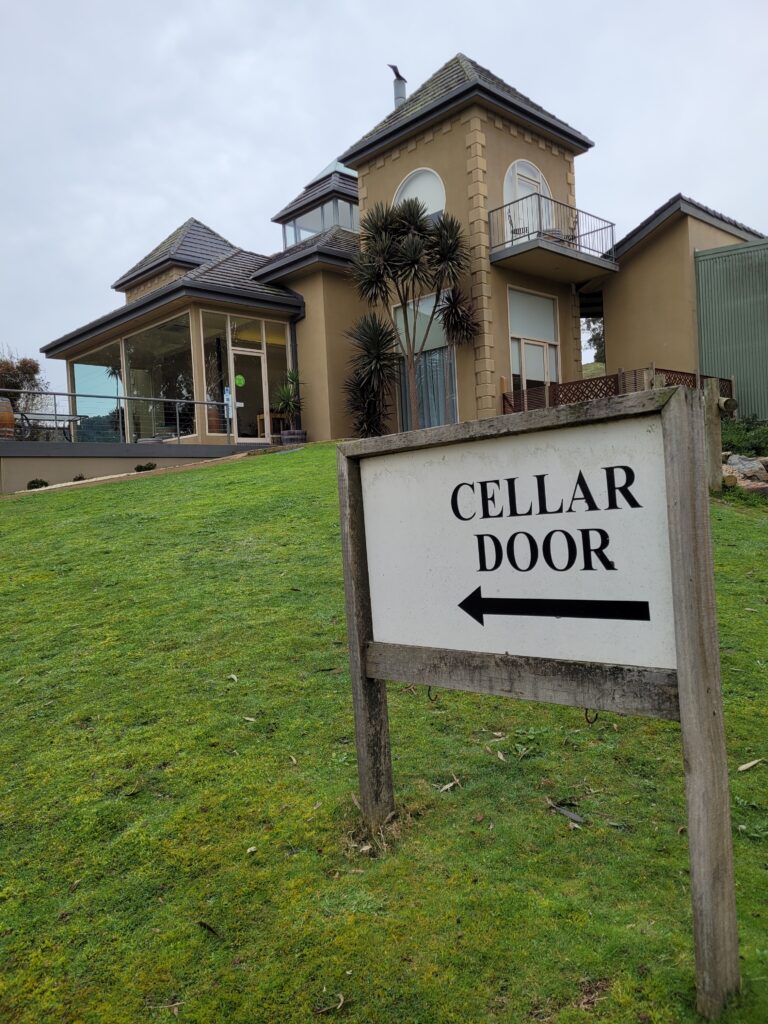
Sutherland Estate is a small, family-owned enterprise located at Dixon’s Creek. The Cellar Door design is cathedral-ceiling with enormous floor to ceiling windows. It is situated high on a hillside and has a large outside deck with impressive views of the vineyards. You can see the expanse of the Yarra Valley and Dandenong and Warburton Ranges. It’s a lovely place to quietly to sip wine, perhaps pair it with a cheese board, while taking in the views and birdsong. You can also stay overnight with two small apartment style rooms with spiral staircases leading up to the bedroom and views, designed like a tower either side of the building.
I met with Cathy who told me that her parents established the vineyard and Cellar Door here, and now she and her family as the next generation have taken over the reins.
Chardonnay is planted here, as well as Pinot Noir, and their sparklings highlight the red grape varieties with a Blanc de Noirs (white from black). They also have the Spanish-origin Tempranillo planted here and have created a unique sparkling red with this variety.
2016 Blanc de Noir Sparkling
Made from 100% Pinot Noir in the méthode traditionnelle, with secondary fermentation and ageing in the bottle. Using all red fruit that hasn’t spent time on skins, presents as a white sparkling wine. Sometimes you’ll see a hint of blush in the colour like this one. It is late disgorged after 4 ½ years on lees, resulting in a complex and generous sparkling. Aromas of pastry, brioche, honey, pear and almond. On the palate it’s well balanced with mid-palate fruit – berry, cherry and marzipan – and finishes dry at only 3g/L dosage, with a lovely fine and persistent bead.
2021 Sparkling Tempranillo
This was the latest release, and it is something unique as a sparkling red because we don’t often see a Tempranillo here in Australia. They’ve been making it for 10 years, and it’s all grown onsite, and has spent months in seasoned barriques before undergoing secondary fermentation on lees in the bottle made méthode traditionnelle, it’s aged on lees for 12 months. It is almost inky purple in colour. As is often the case with a sparkling red, it is higher on dosage at 25g/L to balance out the tannins, but it finishes dry. It has a powerful burst of mid-palate fruit of berries, dark cherries, a bit of liquorice, with peppery spice and earthy undertones to finish. It would be a great match with cheese and charcuterie or even a dark chocolate pudding.
Steels Gate Cellar Door
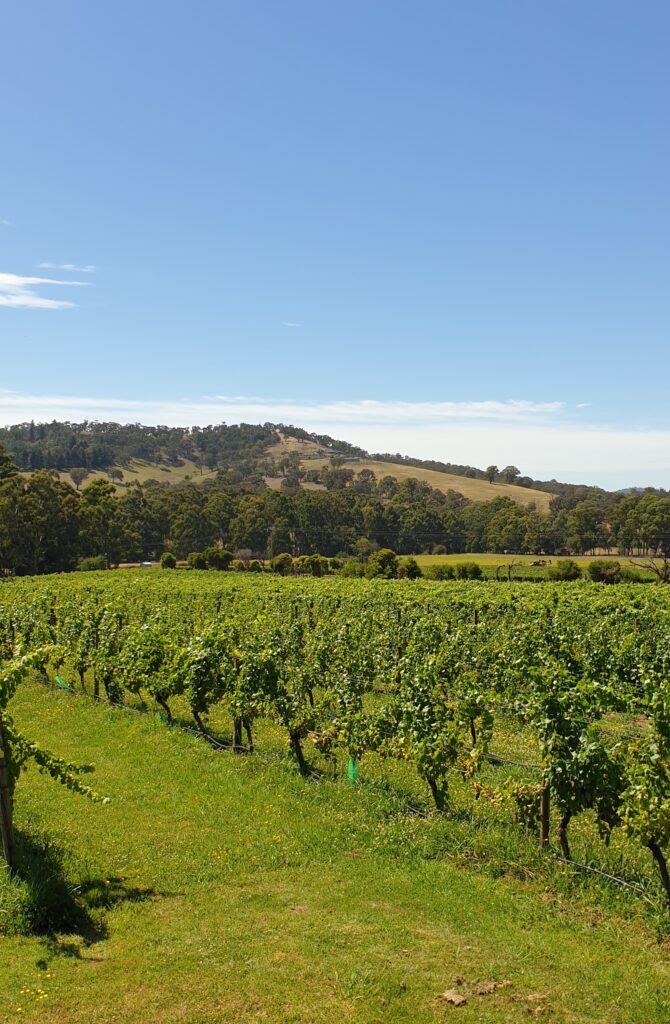
Steels Gate Home Block Vineyard is situated at 230m above sea level and was planted in the late 1970s on an undulating slope on grey loam soils.
I met with Matthew and Brad who purchased the Home Block vineyard in 2009. They explained that the site was overrun by blackberries and the vines needed some significant nurturing. They knew it had potential, having previously been used in award-winning wines, and their challenge was to return the vines to their former glory. It is at this site that the Steels Gate winery is located.
It wasn’t until 2017 when Matthew and Brad decided they needed to expand their business and get out of the corporate world. After investigating all alternatives, they discovered an amazing vineyard with restaurant and Cellar Door for sale in Dixons Creek, which they acquired in early 2018. This new purchase tripled the size of their estate and in addition to adding more Chardonnay and Pinot Noir, it diversified their estate offerings with other varieties. If you follow them on Instagram, you may know that their son Sebastien is following in their footsteps, with some of his own vintages created at 11 years of age!
They follow sustainable agriculture practices and their winemaking techniques are centred around minimal intervention and are vegan friendly. The restaurant and Cellar Door were upgraded with additional solar panels providing significant green energy back to the grid.
Initially expecting to run a Cellar Door with “café” type food, they suddenly found themselves needing new skills as restaurateurs for the first time. Demand for top quality food was what visitors were asking for, and the restaurant has a head chef and is recognised with 5-star ratings.
Situated in the valley, the Cellar Door has an indoor area and deck with views over the vineyard and surrounding ranges. A kitchen garden provides produce for the restaurant and themed dining nights. The cellar door and restaurant is open a few days a week, for tastings and lunch, Saturday night dinner, and there are platters available to enjoy on the picnic tables at other times.
Their dedication and passion for producing quality sparkling is evident. All hand-picked and methode-traditionelle, aged in bottle for around three years. Since my visit, new vintages of the Blanc de Blancs and Blanc de Noirs have been released. I look forward to trying them in the future.
2017 Blanc de Blancs Home Block
The Home Block vineyard is cool and sheltered with more than 40-year-old dry-grown vines. This vintage – 100% handpicked on 28 February 2017 – produced an amazing sparkling that displays a crisp dry, creamy textured, fine-bead and lingering beeswax finish. De-stemmed and pressed, with overnight juice settling. Fermented and matured in stainless tank. Method-Traditionelle, disgorged December 2020 with a dosage of 5g/l.
De Bortoli
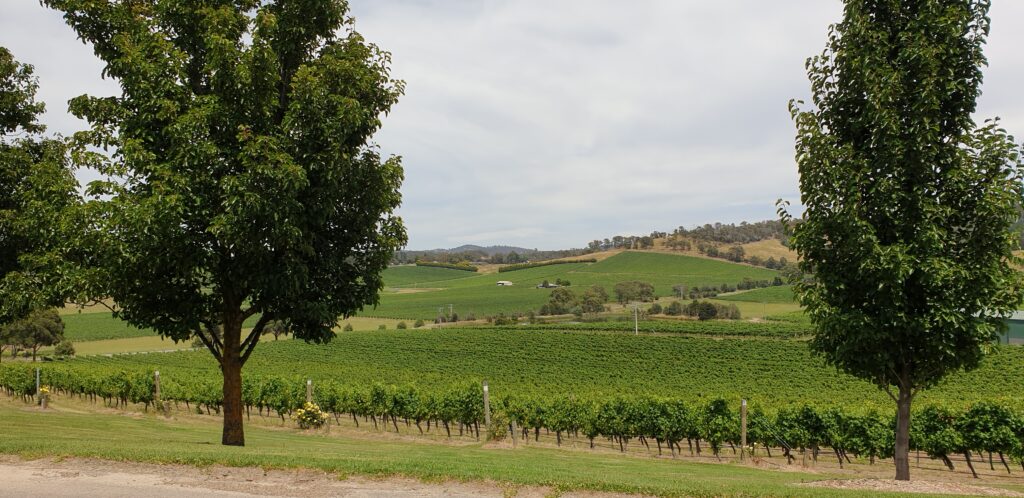
You probably know this label, but you may not be familiar with the De Bortoli family story, which is one of determination and triumph that started 90 years ago in war-torn Europe and is now told, generations later, across Australia. Their heritage encompasses the universal story of immigrants making good in an adopted land, bringing a new wine culture to Australia, and contributing to the rise of the Australian wine industry. A tale of a hardworking and innovative family who consider good wine, good food and good friends to be among the true pleasures in life.
Today, the third generation of the De Bortoli family, the children of Deen and Emeri De Bortoli, are the custodians of De Bortoli Wines.
Managing Director Darren De Bortoli oversees the winemaking, alongside Leanne De Bortoli’s winemaker husband Steve Webber. Leanne and Steve manage the Yarra Valley Estate winery and vineyard, while Kevin De Bortoli is Company Viticulturist, and youngest son Victor De Bortoli is Executive Director looking after international business.
Every family member has pride in, and a commitment to, the business, alongside a passion for great wine and a sense of responsibility about leaving a legacy for future generations.
Chief winemaker Steve Webber says that to make wines of “detail, texture and minerality, charm and interest” it must be about “site and season”.
Chardonnay comes from their high-altitude vineyard Lusatia Park in Woori Yallock, a premium vineyard where Pinot Noir is also in planting.
The Cellar Door has an Italian-style restaurant offering local produce embracing the family’s European heritage. Bookings are recommended at the restaurant, which is open four days a week, as well as the Cellar Door, which is open daily. There are a few tasting options including:
Premium Wine Tasting – Enjoy a guided tasting of eight wines from our Estate and Single Vineyards, showcasing classic varietals from our iconic Yarra Valley sites. Learn about winemaking techniques and the story behind the De Bortoli family from the friendly and knowledgeable staff. Allow 30 minutes for your tasting.
Private Gourmet Tasting – Treat yourself to a truly decadent tasting at the De Bortoli Yarra Valley Cellar Door. This privately hosted experience is set in the Trophy Room or VIP Room, exploring the iconic wine varietals from the region and beyond. Learn about winemaking techniques from vine to table and the story behind the De Bortoli family. All wines are expertly matched with a fine selection of cheese. Allow one hour for your tasting experience, which includes Single Vineyard and Premium wines, and a dedicated wine expert for the full hour.
De Bortoli have a large sparkling list – mainly charmat method showcasing Italian style and flair with great label designs. The list has something for everyone, including the prestige-themed La Boheme sparklings, which are Chardonnay-led blends with Pinot Noir and Pinot Meunier and high percentage of reserve wines, the Rococco range with similar blend of three, a sparkling Shiraz, several different Proseccos (Glera) including a Kylie Minogue Prosecco Rosé, a few Moscatos for sweets, and Fizzero for no alcohol. Having tasted a lot from the range, on this visit I selected just a few starting with one that I hadn’t tried before – the Este – a Methode-Traditionelle that was a recent edition released to the range, as well as La Boheme, which we recently proudly featured as one of The Bubbles Review giveaway prizes.
Este Vintage Cuvée 2008
66% Yarra Valley Pinot Noir, 34% Yarra Valley Chardonnay.
Fine aromatic nose, citrus fruits, herbs, and ripe apples. Chalk, grain, and biscuit notes, textural and balanced. Intense with savouriness, structure and quite gastronomic in its feel. It spent 6 years ageing on lees and is in the Brut Nature range with only 2gms of residual sugar.
La Bohème Cuvée Blanc
93% Chardonnay, 7% Pinot Noir. 56%.
2015 vintage, 10% 2014 vintage and 34% reserve wine (2007 to 2016).
Beautifully styled bottle and label. Charmat method. Pale colour with a green tinge. Citrus, hazelnuts, brioche, complex and lifted aromas. Finesse and complexity on the palate, lively with good weight and balance. Residual Sugar 8.5g/L. Perfect with antipasto platter of cured meats, salami, paté, or cured salmon.
La Bohème Cuvée Rosé
66% Chardonnay, 22% Pinot Noir, 8% Pinot Meunier, 4% Pinot Blanc.
Charmat method. Very pale rosé colour. Cream and biscuit, hazelnuts, brioche, complex and lifted aromas. Fine and textural on the palate, lively with good weight and balance. Enjoy now with a selection of canapés. Residual Sugar: 7g/L.
Mandala Wines
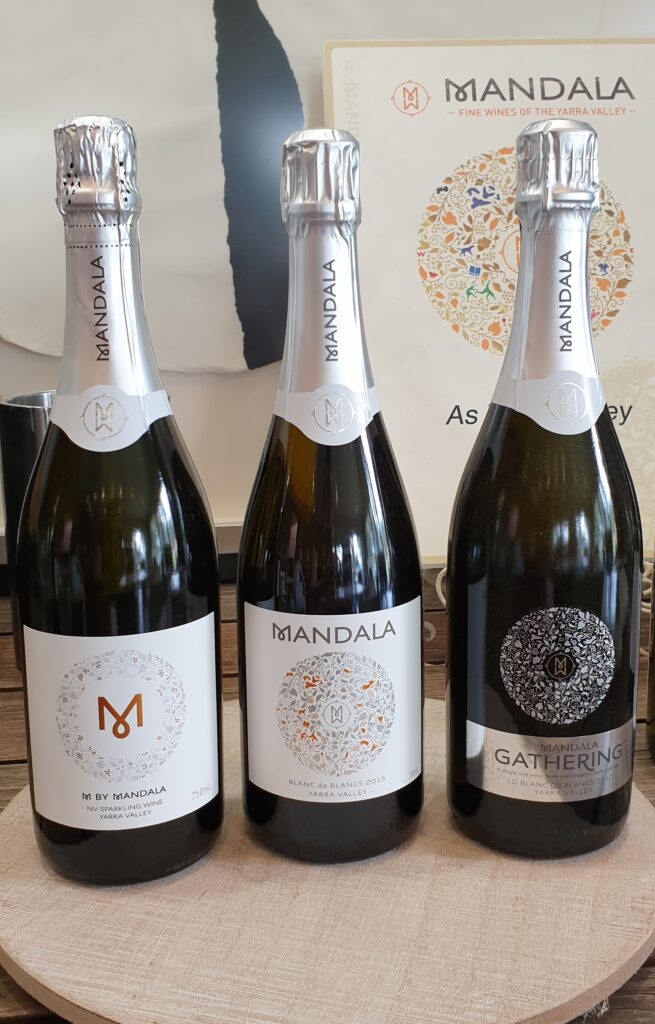
Mandala was a family dream going back generations – a place to grow grapes, make wine and share it with friends and family. The first part of the ‘dream come true’ was when the Smedley family planted their first ten acres of Pinot Noir at a site in Yarra Junction in 1999. Several years later, they were ready to expand. The story goes that it was Nanna who sent images in a dream to Mum one mysterious night – a vision of rolling hills, dams, vines and a place to sit at the end of the day taking in an endless view. A year later, that dream became a reality when they moved into the site at Dixon’s Creek, and together with the Yarra Junction vineyard, came full circle to create Mandala as it is today.
I first met owner and winemaker, Charles Smedley, at a wine-tasting event. I loved hearing the story about the winery, and Charles took extra time to talk to me about the Mandala logo and name. Mandala is a Sanskrit word for sacred circles, where everyone has their own things that are important to them. The Mandala wine label is about spending time with family and friends enjoying good food and wine.
Their favourite wines lead them to the Yarra Valley region – Charles’ love of Pinot Noir and Chardonnay – made it the perfect choice.
Onsite under separate management is the DiVino restaurant serving Northern Italian cuisine by Chef Luca Radaelli. The kitchen team follow the same philosophy as the Mandala winemaking team, focusing on high quality, locally sourced and seasonal ingredients. We had a lovely lunch here the ‘glasshouse’ dining room with views across the vineyards.
The Mandala Cellar Door is set in the entrance to the same building in a beautiful Yarra Valley country setting. With outdoor spaces and views to the vineyards, the team can point to the vines that made the wine you are tasting. Charles says they want Mandala to be our legacy for the future generations, and to be indulged by whomever catches the wine bug – “our place is your place”.
All current release wines are available to taste every day, with the Single Site reserve range named with different meanings for different family members. The Cellar Door also offer back-vintages, Museum stock specials, and limited releases available that are exclusive to the Cellar Door.
The NV ‘M by Mandala’
70% Chardonnay, 30% Pinot Noir.
The fruit bunches were harvested early to ensure freshness and a balance of acids. This is a cool climate trophy wine, the NV “M by Mandala” blend of premium Chardonnay fruit delivers striking lemon zesty and light sherbet characters, whilst the Pinot Noir contributes to the feel and weight on the palate along with spice essences. Matured stone-fruits and a creamy mid-palate are brilliantly maintained with an extended finish of crisp, natural acidity and a fine bead. Perfect for an arrival drink, pool-side bubbles, spontaneous celebrations, and party starters. Food pairing suggestion – range of antipasti, such as cured meats, olives, sun-dried tomatoes, and cheeses.
The 2015 Mandala Yarra Valley Blanc de Blancs
100% Chardonnay.
Methode Traditionelle, it has a creamy, textured palate and a fine bead open up golden apples and ripe nectarines in the mouth. Brioche and honeyed characters are balanced by a long finish of tightly structured lemon-lime acidity and a refreshing minerality.
The 2010 Mandala Yarra Valley ‘The Gathering’ Blanc de Blancs
100% Chardonnay.
‘The Gathering’ tells the story from the Mandala, in surrounding yourself with good friends and family while enjoying and embracing life. Methode Traditionelle, spending an impressive 78 months in bottle to produce a truly elegant and stunning wine.
Lovely nose with aromas of lemon rind, white flowers, and brioche. A creamy, textured palate and a fine bead open up textural almond meal and finish with honey nectar, ripe nectarines and stone fruit. These characters are balanced by a long finish of generous structured citrus acidity and a refreshing minerality. Food pairing suggestion include a range of shellfish, white fish, vegetable-based pasta, and paté.
Other names in still wines in the Mandala reserve range are ‘The Compass’ – “four points lead to home”. Charles has symbolised the four points in his Mandala to his four children who always centre him and guide him home. The ‘The Matriarch’ is named for his mother – the head of the Smedley family, the link between family and vine, the leading spirit and adoring mother overseeing and caring for all. ‘The Rock’ for his father, who is the infamous “rock” of the Smedley family, and ‘The Butterfly’ is lovingly dedicated to Charles’ late sister Vanessa, who’s name in Greek means “butterfly”.
Balgownie Estate
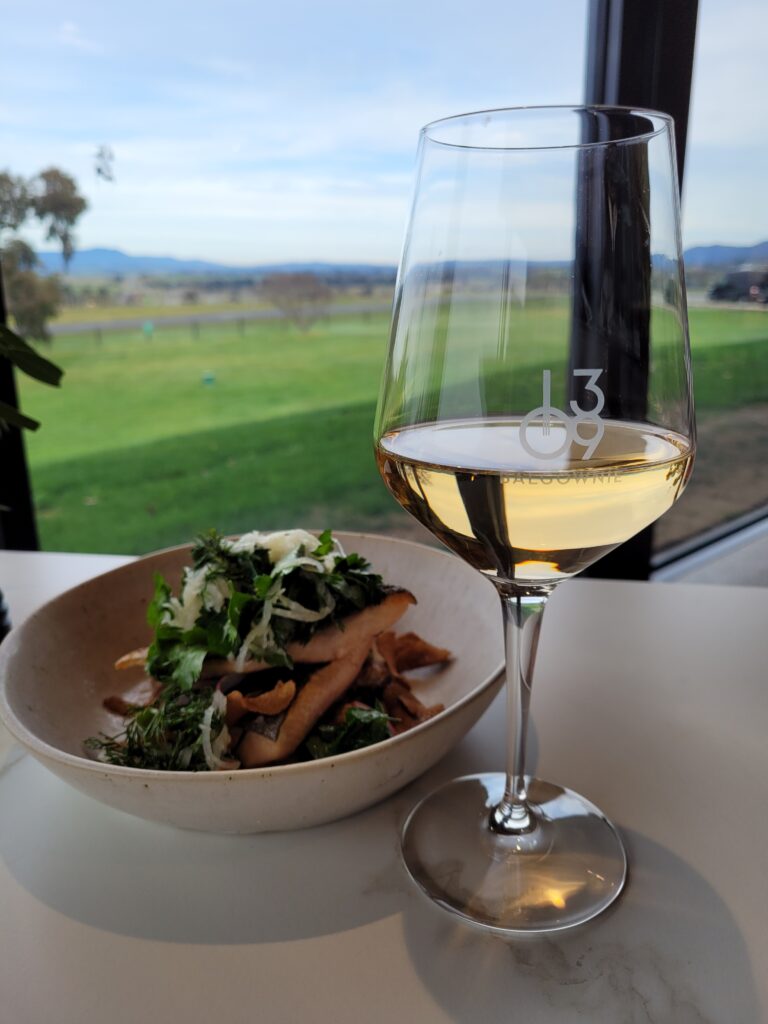
The original Balgownie vineyards are in Bendigo, where they produce their well-known Balgownie Estate Cabernet Sauvignon and Shiraz, with the first wines vintaged in 1972. The Yarra Valley vineyards are producing elegant cool climate wines from estate-grown Pinot Noir and Chardonnay.
Balgownie Estate Yarra Valley is home to 17 acres of vineyards – about 50-50 Pinot Noir and Chardonnay. A stylish new building houses resort reception, restaurant, bar, function space and Cellar Door.
The previous restaurant was damaged by fire and the temporary dining facilities were only for guests in their hotel room and suite accommodation. Luckily for me on my recent visit, the brand-new build for restaurant 1309 @ Balgownie was finished and is now open to the public. 1309, named for their street number on the Melba Highway, houses an elegant dining experience with modern Australia cuisine available in the luxurious restaurant building, or on the deck for open-air dining with beautiful vineyard and Yarra Valley views. An Endota spa has opened here, and there is resort style accommodation, with the restaurant providing breakfast, lunch, and dinner. The Balgownie tagline is Wine – Dine – Stay – Spa, at Balgownie Yarra Valley. A recent accolade for their new build at the TAA (Tourism Accommodation Australia) awards was a win for Hotel Bar of the Year.
The Cellar Door has areas for private and group tastings, as well as up at the bar where I enjoyed my tastings. I was impressed to find there is a specific tasting for the Sparkling range, which covered four different sparkling wines.
Sparkling Premium Cuvée Brut – NV
100% Chardonnay.
A portion of this wine was fermented in old oak barrels with extended lees contact to provide some toasty and bread characteristics. The balance was fermented in stainless steel tanks to preserve the fresh fruit aromas and flavours, then carbonation method was used for bubbles.
Palate is bright and lifted aromas of pear, citrus and new season apples with hints of guava and passion fruit. It has creaminess on the palate with a crisp finish. Serve for brunch or as an aperitif.
Sparkling Shiraz – NV
95% Shiraz and 5% Cabernet.
The fruit sourced for this sparkling red is from the Bendigo vineyard. It was hand-harvested and fermented in open vats with daily hand plunging. A brief post-fermentation maceration was carried out to enhance the integration of fine tannins. The wine was aged in a combination of seasoned French oak barrels, and a 10% addition of base wine from the 2013 vintage was added for complexity.
Deep, bright red/purple colour. Fragrant berry aromas, notes of oak and some aniseed spices. The palate is full-bodied, noted tannin and superb balance. Berry richness on the palate of juicy cherries and blackberries. It’s rich with a sense of sweetness the dosage is 19.5g/L. Food pairing suggestions include an array of cuisines from Chinese to Mexican.
Macedon Sparkling Pinot Noir Chardonnay 2018
70% Pinot Noir, 30% Chardonnay.
Hand-harvested from the Cleveland vineyard in the Macedon Ranges, March 2018, this Methode Traditionelle this is their flagship sparkling wine, having spent 3 years ageing on lees in bottle.
Aromas of white flowers, brioche pastry and citrus alongside grilled peaches. The fine mousse carries the lovely rich palate framed by fine natural acidity. It is in the Extra Brut range with a dosage of 4g/L. Lovely mid-palate berries from the Pinot Noir and almond. Shows excellent length with layers of complexity. I chose to have a glass of this with my lunch in the restaurant afterwards, and it was a great food match with a range of dishes.
Macedon Sparkling Pinot Noir Rouge 2018
100% Pinot Noir.
Hand-harvested from the Cleveland vineyard in the Macedon Ranges on March 2018, this Methode Traditionelle was disgorged in October 2021 after 3 years on lees.
Made in the style of a classic sparkling red, this wine displays hallmark aromas of wild strawberries and red cherries with notes of spice and subtle earthiness. The medium-bodied palate is carried along by a combination of fine tannin and soft acidity. The fine bead further expresses the elegant light to medium bodied palate with some lovely berry fruit characteristics in the mid-palate. It has a dosage 19g/L, but due to the balance with tannins it tastes as dry. Food pairing suggestions are home-baked turkey or roast pork with crackling.
COLDSTREAM AREA
Situated in the centre of the wine map, this area boasts some of the big sparkling names of the region.
Punt Road Wines
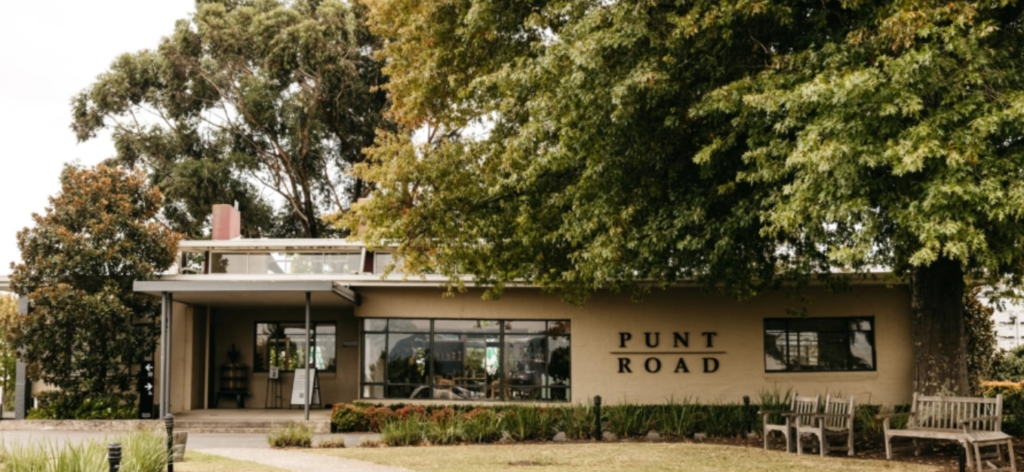
All Punt Road wines are produced from the more than 150 acres of estate-grown vineyards in Coldstream. A family-owned vineyard and winery, creating wines with careful reflection of the heritage of this site, and the independent, creative energy of the Yarra Valley.
Grapes have been grown at this site since 1861. Hubert de Castella, one of the original Swiss vignerons of the Valley along with the De Purys of Yeringberg, pioneered winemaking in Victoria, and won trophies for his wines the world over. The family say they’re proud that this magnificent vineyard is still winning trophies today.
The vine cuttings that were planted in de Castella’s vineyard were sourced from the ‘Airlie Bank’ vineyard, located where punts once carried people and horses across the Yarra River from Jolimont into South Yarra before the Punt Road bridge was built. Now, the winery is in Coldstream, nestled amongst the Napoleone Vineyards (planted in 1987) and apple orchards. The Napoleone family have been growing fruit in the Yarra Valley since 1948, when Giuseppe Napoleone emigrated from Abruzzo and planted an apple orchard in Wandin.
As you come down the driveway of Canadian maple trees, a Pink Lady apple block is on the left, and the Block 12 Pinot Noir on the right (planted in 2009 after the Black Saturday bushfires raced through the property). All the fruit for their wines (and the ciders they produce) come from this property.
The cool climate of the Yarra Valley and the fertile soil of the site allows them to craft elegant, detailed wines that are winning awards. Hubert De Castella would be proud.
Aside from the Cellar Door, they sometimes have ‘pop-ups’ with food trucks. An Orchard Bar for cider, including cocktails and calvados. There’s also a monthly Farmers Market. After your tasting you can order wine by glass and enjoy with cheese platters.
The Cellar Door offers a 30-minute seated tasting experience, with accompanying nibbles, showcasing five of their favourite wines, but you must book in advance. In 2021, they were awarded Gourmet Traveller’s Best Yarra Valley Tasting Experience. On my visit, I chose to taste their sparklings, of which there were three.
Airlie Bank NV Yarra Cuvée
85% Chardonnay, 15% Pinot Noir.
The NV Airlie Bank sparkling blend is sourced from within the Yarra Valley. Small portions were barrel fermented and given extended time on lees to build texture and complexity. Aromas of citrus fruits and subtle apricot, complemented by a doughy, bready complexity. The palate is fresh and vibrant with a focused palate structure of apple blossom and citrus characters with complex brioche notes.
Airlie Bank NV Yarra Rosé
82% Chardonnay, 18% Pinot Noir.
Small portions were barrel fermented and given extended time on lees to build texture and complexity. The wine is fresh and vibrant with a focused nose and palate of orange blossom, delicate strawberry, lemon, and complex brioche notes.
Punt Road Yarra Valley 2015 Sparkling
90% Chardonnay, 10% Pinot Noir.
Hand-picked from the Napoleone vineyard. Methode Traditionelle, aged for 3 years on lees. Complexity on the mid-palate with lovely creamy bead, low dosage creating a dry crisp finish.
St Hubert’s
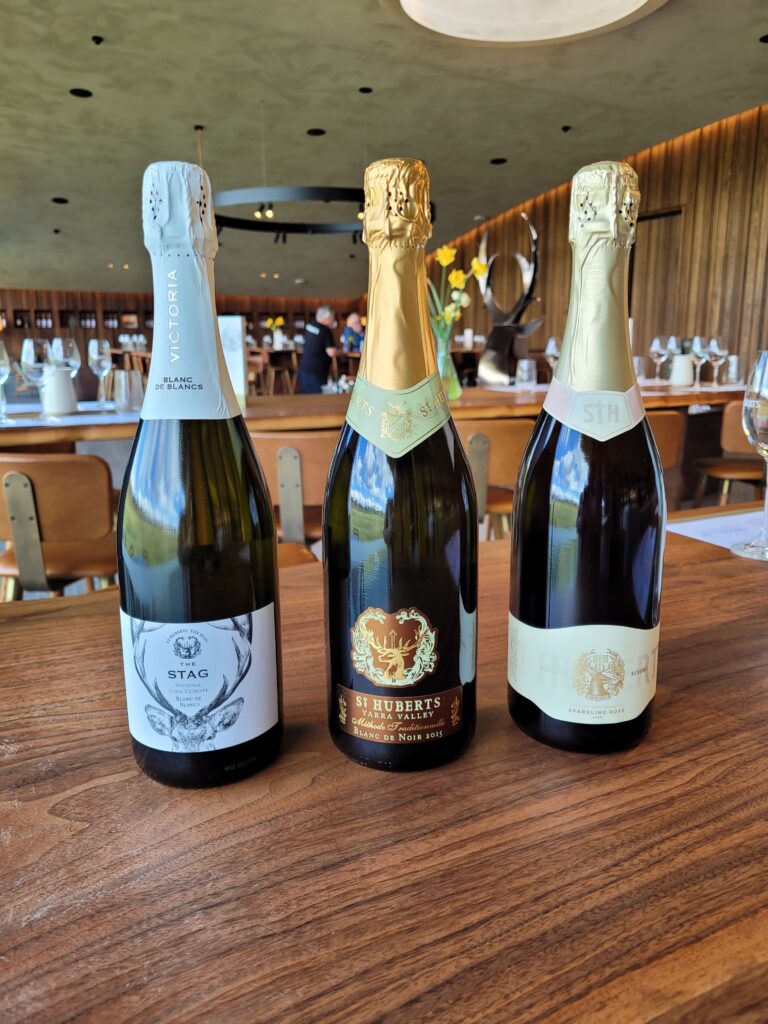
Established in 1862 as one of the first wineries in the region, St Hubert’s helped position the area as a premium wine-producing location, before championing the Yarra Valley’s wine renaissance in the 1960s.
As one of the pioneers of premium winemaking in the area, St Hubert’s sought to upgrade their Cellar Door experience and were closed for renovation in recent years to re-open, having created an innovative premium cellar door experience. The Cellar Door and tasting room is located under a hill created in the lawn overlooking the vines – a unique entrance that gives the impression of a subterranean building. Inside you’ll find sleek and stylish interior design, and the rich-looking tasting room, wine shop and art gallery below. They serve a small selection of local cheeses and charcuterie to accompany your wine experience.
Under the Cellar Door roofline they house a wine shop, showcasing not only their own wines, but also focusing on emerging varieties or new wine making techniques, and stocking up to 70 different wines from other brands from other regions across Australia. These wines are free to taste whilst you browse the range in store.
St Hubert produces three sparklings in their ranges, one from the Stag range and one from the St Hubert’s range. The tasting room offers two tasting flights where you can choose three wines from either the Stag range or the Premium tasting flight from the St Hubert’s range, which includes their two Méthode Traditionelle sparklings.
NV The Stag Blanc de Blanc
100% Chardonnay.
This is a Charmat method, fresh and zesty with primary fruit flavours and good acidity. It’s 8.5g/L dosage, dry and crisp.
2015 St Hubert’s Blanc de Noir
99% Pinot Noir and 1% Chardonnay.
Méthode Traditionelle from carefully selected parcels of Yarra Valley fruit. Hand-picked, gently whole bunch pressed and fermented in the bottle. The wine has 6 years on lees. A dosage of 6.5 g/L
The colour is pale to medium straw with bronze hues and a fine, persistent bead. The aromas include orange blossom, apple and hints of fresh bread, bees wax and almond meal. On the palate, beautiful fine mousse precedes a creamy and rich and yet tightly structured. Crisp apple crunch, nougat, French pastry, and citrus blossoms are evident. The wine is restrained and vibrant, and the finish is long.
2015 Sparkling Rose
100% Pinot Noir.
Upper Yarra Pinot Noir made Méthode Traditionnelle, 6 years on lees. Lovely pale pink in colour. Aromas and flavours are apple pie, nutty nougat, faint red currant, and blood orange. A supple mousse with balanced acidity and good drive. A dosage of 6–7g/L it is dry on the palate and a lovely salty finish with hints of pepper spice.
Yering Station
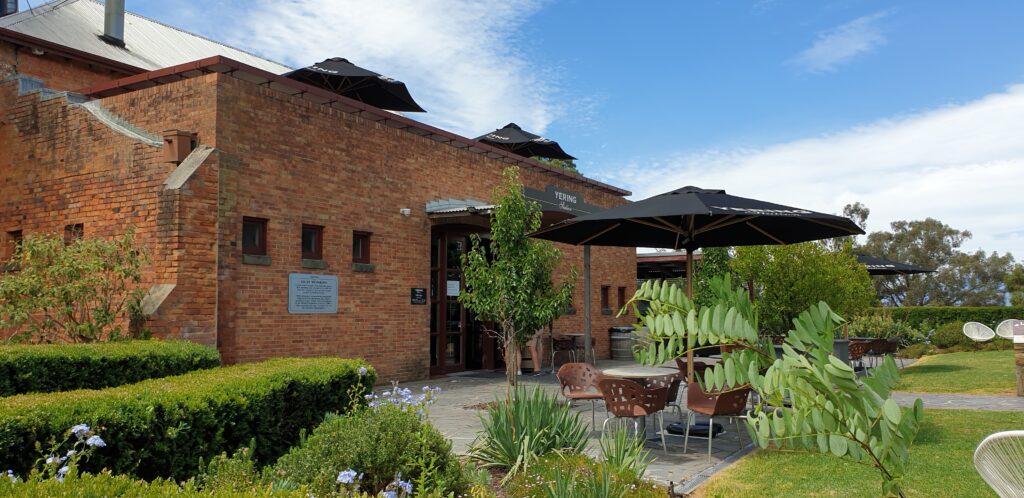
With vines first planted in 1838, Yering Station is proudly Victoria’s first vineyard. A jewel of the Yarra Valley, they produce world-class cool climate wines from our vineyards, which are famously renowned for their expressive varietal integrity. After changing hands several times throughout the early-to-mid 1900s, Yering Station was purchased by the Rathbone family in 1996.
As lovers of wine with a rich family background in agriculture and engineering, their purchase of Yering Station marked the beginning of their wonderful wine journey. A true family operation, the Rathbones went on to build what is now an icon of the region. A simple and pure vision powered their passion.
“When we first started out in 1996, our ambition was to simply make great wine.” – Darren Rathbone, CEO and Winemaker.
Considered one of the region’s leading wineries, the wines attract attention and admiration from wine lovers across the globe. So too does this estate. It’s a little like a destination with its historic Cellar Door, a converted barn event space, and the stunning signature restaurant with amazing architectural design overlooking the vineyards, making for a truly unforgettable Yarra Valley wine experience. I first visited here around 18 years ago when I was a judge in the Victorian Tourism Awards. Over three years, I judged many places and this visit stays with me as one of the most memorable experiences. The winery is visually stunning and that alone makes it outstanding, but it was also the passion of Darren Rathbone who showed me around and at each different location at the winery, introduced me to the team member responsible for that area that clearly demonstrated the sense of pride that each everyone had in this place. Victorian Tourism Award winners they became that year and then successfully went on to achieve Hall of Fame status.
Bookings are recommended for the restaurant, and you can also order picnic hampers from the restaurant to picnic in the grounds.
The heritage Cellar Door and wine store is housed in the original winery building circa 1859. The tasting bar experience provides a guided tasting by a team member. The educational nature of the tastings takes visitors on a wine journey through the Yering Station wines.
The Cellar Door is open seven days a week, tastings at the Tasting Bar are on a walk-in basis, and there is no need to book unless your guest numbers are 10 or more. There are three options for a progressive wine journey through their collections either the Village series – Yarrabank and Estate or Single Vineyard and Reserve. Different pricing for each with tasting fees redeemable on purchase. Groups can also book a Private Group Tasting or Wine Tasting and Grazing experience by adding food pair options of cheese plates or shared grazing plates, held either in the Scarlett Room or upstairs in Matt’s Bar. For the ultimate experience, there a Deluxe Tour and Tasting (min 6 people) which is an indulgent varietal-specific wine journey. Choose your varietal journey from their flagship Chardonnay, Pinot Noir or Shiraz Viognier. Experience includes a glass of Yarrabank Sparkling, a guided tour of the underground cellar, 6 tasting wines from the Estate, Reserve and Museum collections along with crackers and breads for tasting accompaniments.
Yarrabank is the sparkling brand of Yering Station. This is another Yarra Valley sparkling with a French connection as this highly successful sparkling brand was established as a joint venture between Champagne Devaux and Yering Station in 1993. I tasted two different cuvées on my visit.
2013 Yarrabank Cuvée
56% Chardonnay, 44% Pinot Noir.
A centuries-old tradition from Champagne meets modern Yarra Valley winemaking, made in methode traditionelle. A beautiful palate celebrating the union of Pinot richness and Chardonnay vibrancy. Hints of vanilla slice and citrus fruits are supported by an elegant oyster-shell minerality. The colour is ripe golden straw with a fine, persistent bead.
Complex aromas of toasty Anzac biscuits, ginger spice, and honey, with fresh fruits of ripe summer plums and orange zest.
Lovely delicate on the palate balance of rich biscuit-y flavours and fresh vibrant fruits of red apples, citrus and tart strawberries. A lovely creamy mousse and with 4g/L dosage it has a refreshing aperitif finish that is long and rewarding.
2013 Yarrabank Brut Rosé
56% Chardonnay, 44% Pinot Noir.
Also methode traditionelle, this is a similar blend to the cuvée, but using the assemblage method to create the rosé, it has had 1% of still red Pinot Noir added to create the colour, which is a lovely light salmon pink. On the nose it has interesting earthy aromas and on the palate flavours of citrus, melon, and hints of strawberry, along with freshly baked bread, which adds to the complexity. A long, lively mouth feel with fine bubbles, tight acidity and a sumptuous texture providing a crisp, dry finish and strong persistence. 7g/L dosage.
Chandon
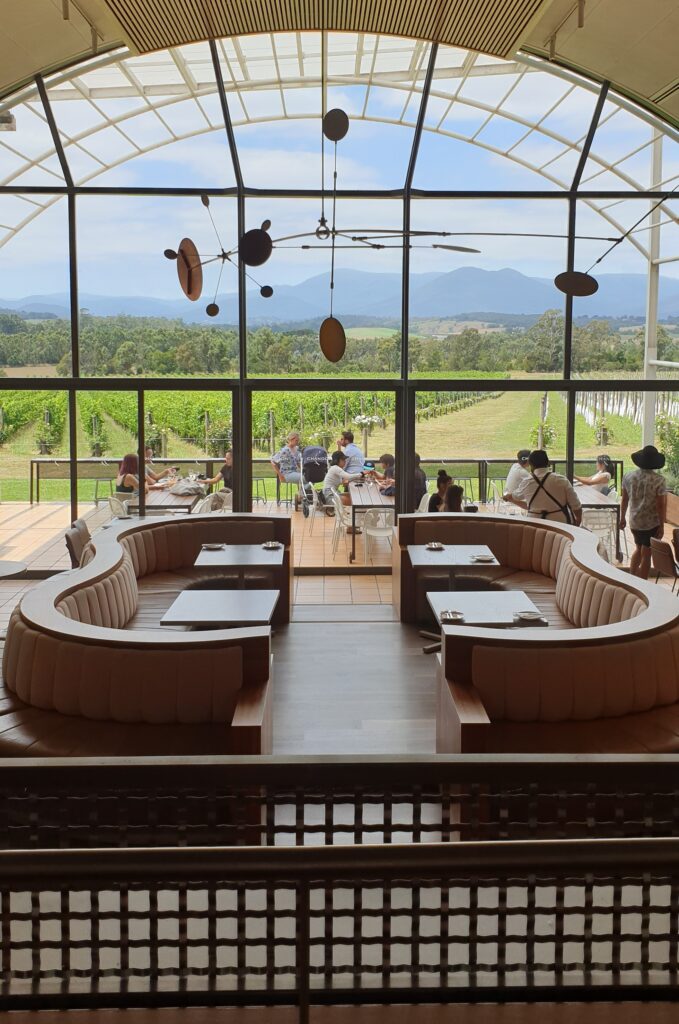
Sixty years ago, Robert-Jean de Vogüé of Moët en Chandon and an assortment of his closest friends set out to redefine luxury sparkling wine. They decided the only way to bring it into the modern world was to take it far, far from home. That journey of rediscovery began in Argentina and eventually took them to California, Brazil, China, India and, of course, all the way to Australia.
John Wright, who ran Chandon California at the time, took a risk on our land of opportunity. He visited Victoria in 1982 and was chuffed with the can-do spirit of the Australians. The boss, Phillipe Coulon, visited soon after and gave his tick of approval. They then tasked the legendary oenologist Tony Jordan with the unenviable task of finding the perfect land to begin a vineyard.
As the story goes, if Tony had just thrown a rock in any direction, he probably could have hit a decent piece of land for winemaking. But Tony wanted something truly special – a cool-climate area with enough diversity of terroir to give him all the blending options he could dream of. The Yarra Valley was the natural choice, and Tony loved it so much he couldn’t leave. The first cuvées were released in 1989 under the new Chief Winemaker and head rock thrower, the one and only Tony Jordan.
Creating sparkling wineries outside of Champagne allows the winemakers freedom to explore all sorts of techniques that cannot be used under the strict rules and regulations of Champagne. You can read more about this on our blog – Why that’s not a glass of champagne that you’re drinking – when I interviewed the Chandon winemaker Dan Buckle.
I love the Chandon Cellar Door, and have visited many times over the years, beginning in the mid-1990s this was also a stop on our TAFE tour guide training itinerary, the guided tour and instruction on Methode Traditionelle winemaking here was superb. Some of my more recent visits include celebrating here on the first stop an itinerary with a group of 50 of my closest friends for one of my milestone birthdays.
The full tour through the winery, bottling line, riddling hall, finishing with a breathtaking reveal to the Green Point room, is no longer in the program, but there are still some amazing experiences here. The name Green Point came from the point in the apex of the valley that was the first point to turn green after summer.
Dining experiences include the restaurant where you can have a three course chef’s menu matched with sparkling wines. The Lounge Bar offers small plates to enjoy with a glass of sparkling or tasting flight, a Sparkling Brunch on weekends or a Chandon Garden Spritz picnic.
Cellar Door tasting experience now include The Foundation Tasting, The Exploration Tasting, or the Chandon Sparkling Masterclass, which allows you to take a leisurely stroll through the grounds and the fabulous Riddling Hall before finishing in the privacy of the Whitlands tasting room.
You may be familiar with Chandon available everywhere in bottle shops, bars and restaurants, but the special feature of the Cellar Door visit is special releases of blends and vintages that you won’t find anywhere else.
Here are a few examples.
Chandon Vintage Brut Rosé 2015
Pinot Noir, Chardonnay, Pinot Meunier.
Methode Traditionelle. Pale pink, with peach skin hues and very fine bubbles. Classic Pinot Noir stone fruit aromas, peach, and background cranberry notes in the foreground, while in the background fresh dough and biscuit characters derived from long yeast ageing. In the mouth, there is a sense of finesse and delicacy. Pinot Noir fruit characters of red berry and ripe peach are on display, with some grapefruit in the background very fine acidity completes the picture, with length of flavour. Suggested food pairing is perfect with fresh salmon or trout, and terrific with gruyere cheese.
Chandon Vintage Blanc de Blancs 2016
100 % Chardonnay.
Methode Traditionelle. Pale straw with green hues, very fine bubbles, and persistent mousse. Quince, subtle praline, lemon myrtle, seaspray, green pear. A subtle cinnamon spice element derived from oak barrels. Citrus and quince flavours on the palate, with delightful acidity and tension, soft texture with very fine bubbles. Suggested food pairing is sea urchin, Port Phillip Bay mussels with creamy tarragon sauce, and scallops with Thai basil.
Chandon Late Disgorged 2008
Chardonnay, Pinot Noir.
Methode Traditionelle. Pale yellow in the glass, with fine bead and mousse. Complex and delicate lemon verbena, bergamot, lime, baked apple, fresh dough, and meringue aromas. Palate is fine with citrus character and surprising freshness, soft pillowy bubbles, and lovely toast finish. Suggested food pairing with asparagus and goats cheese tart, citrus pavlova and Xiao Long Bao dumplings.
Oakridge
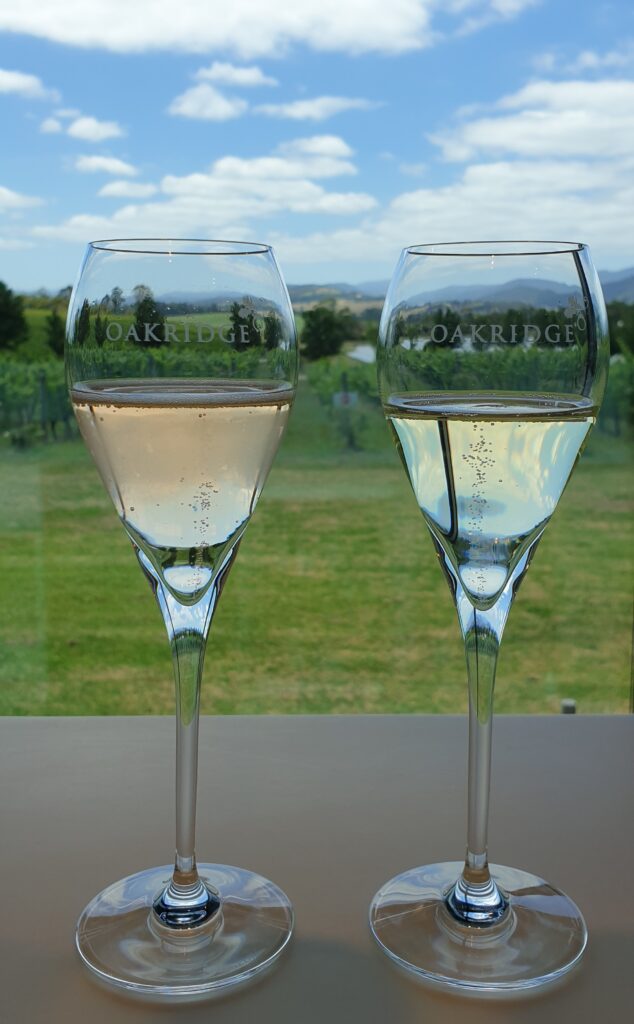
Oakridge is a family-owned winery, restaurant, and Cellar Door, originally established in 1978 alongside a ridge of oak trees – hence the name. Oakridge has grown to become an internationally recognised producer of award-winning wines and must-visit Yarra Valley destination.
As a pioneer of the wine growing region of the upper Yarra Valley, Oakridge is known for producing distinctive single-vineyard wines that reflect the unique terroir of the region. Leading the winery team is Chief Winemaker (and Gourmet Traveller WINE Winemaker of the Year for 2017) David Bicknell.
The Oakridge restaurant is a hatted restaurant, and the beautiful food showcasing local produce including their own kitchen garden is wonderfully enhanced by the amazing views. Floor to ceiling windows that provide a vista looking out over the vineyard creates that “Wow!” factor and is the perfect place for a long gourmet lunch. There is also the option for casual dining with local produce plates on the terrace. The restaurant is open four days a week, so you need to plan ahead if you want to include lunch.
At the Cellar Door there are seated premium tasting experiences to choose from. The Oakridge Experience is the option to taste a curated selection of five Oakridge award-winning wines that epitomise their house style. The 864 Single Block Flight explores their highly acclaimed 864 range, as well as the Chardonnay Masterclass to take a journey through the upper Yarra Valley, renowned for producing world-class chardonnay. Reflecting the unique terroir, contrast back vintages and new releases and discover the subtle nuances of each wine. You can also ask to taste by the selecting a few items, which is what I did to taste the sparkling wines. They have two beautiful vintage sparklings, and these are the vintages I tasted during my visit:
2015 Sparkling Blanc de Blancs
100% Chardonnay.
Oakridge’s 2015 release of the Local Vineyard Series Blanc de Blancs is Methode Traditionelle, aged on yeast lees for 52 months, which is a long time for an Australian sparkling. With minimal dosage to showcase this beautiful style. Aromas include glazed pastry, sourdough, and green nectarine … so lightly toasty and fresh, and the yeast and a clotted cream character add a sense of depth. The palate is creamy and textural with a delicate with a lacy web of acidity interwoven throughout. Cream, yeast, granny smith apples and buttery pastry flavours flow along before finishing with a preserved lemon-like tang. Flavoursome, complex, and vibrant from start to finish.
2018 Oakridge Sparkling Meunier Rosé
100% Pinot Meunier.
The Yarra Valley has three distinct geographic zones or sub-regions – lower warmer, middle cool and higher cooler sub-regions. Oakridge match particular varieties with the specific sites to give you outstanding examples of single vineyard wines. 100% Pinot Meunier (or also known as Meunier) is rare, it is usually used in a blend with Pinot Noir and Chardonnay, known to balance out the other two. I first tasted one in Champagne, and I’ve only tasted one other in Australia. It really shines as something different, and I highly recommend trying it.
For this wine, single vineyard grapes were hand-picked and chilled overnight before whole bunch pressing to tank for a natural first fermentation. 20% was fermented in old oak to add complexity. Methode Traditionelle for the second fermentation and aged on lees for 2 years. A dosage of 8.5g/L
The colour is a lovely pale apricot-rose with a bright copper hue. Strong meaty pinot aromas, notes of French pastry and cake over flashes of berries and summer pudding. The palate is initially all creamy, textural, and round and flavoured with summer pudding, biscuits and red berries, then the bright acidity snaps the wine into line adding persistence and refreshment.
Dominque Portet
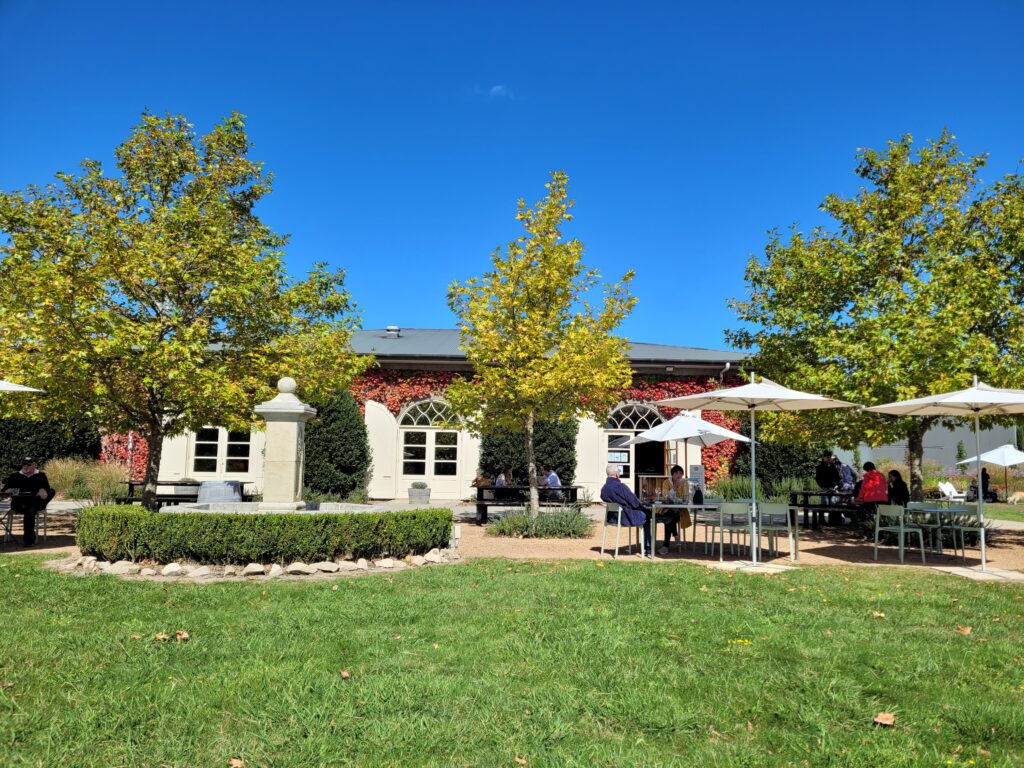
Ninth-generation winemaker Dominique Portet chose the cool climate of aptly named Coldstream in the Yarra Valley as home to the winery he founded in 2000. It was the culmination of a detailed search for grape growing terroir to rival that of his native Bordeaux – but also the start of a new chapter in a winemaking story that has its roots in France in the early 1700s.
Dominque’s first introduction to the world of wine started when he was young when his father André Portet was a vineyard and winery manager of a prestigious winery in France. As an adult, he later spent vintages in the Médoc, Rhône Valley, Provence and with Champagne giant Moët et Chandon, as well as in the Napa Valley at his brother Bernard’s Clos du Val estate.
We should all be very grateful that he chose to come to Australia in 1976, where he has been a pioneer of the renaissance of Australia’s cool-climate wine industry, founding the renowned sparkling wine houses of Taltarni in the Pyrenees in Victoria and Clover Hill in Tasmania. When I interviewed the Cellar Door Manager of Clover Hill for one of our sparkling masterclasses a few years ago, he shared some of the background with me, and how Clover Hill still attributes the success of launching that brand to Dominque Portet. At the same time working alongside another amazing sparkling maker Jean-Baptiste Lécaillon who spent time helping to create the sparkling wine industry in Tasmania at Jansz and is now the Chef de Cave at Louis Roederer (including Cristal). Both men are legends of the sparkling wine industry, and we’re fortunate to have had their influence in Australia and that Dominque chose to establish his namesake winery here in the Yarra Valley.
He has just been awarded the ‘Chevalier de l’Ordre du Mérite agricole’ (Knight of the Order of Agricultural Merit) by the French Government in recognition for outstanding contributions to agriculture. The Order, which was established in 1883 by France’s Ministry of Agriculture, is one of the most important recognitions awarded in France. Dedicating his life to winemaking in France and Australia, Dominique’s distinguished career continues to shape the landscape of winemaking in Australia.
“I found fragrance and structure – most of all the structure reminds me of Bordeaux. The Yarra has a charm, a beauty that engulfs you. The wines are worldly.”
Today, his son Ben heads the winemaking team. Along with the incredible lineage and pedigree that comes with being a 10th generation winemaker, Ben has benefited from the wisdom and experiences of many. That began with four vintages at the renowned Adelaide University finishing school of Brian Croser and Con Moshos at Petaluma in the Adelaide Hills. Internationally he has worked in France in Bordeaux and Champagne at Louis Roederer, as well as South Africa and California’s Napa Valley. Since returning to the Dominique Portet Winery in 2008, he has not only continued the pioneering family wine craftsmanship, but also been a leading industry judge, completing the Len Evans Tutorial scholarship.
The Cellar Door and restaurant’s French Provincial design highlights the French heritage. Set against the rolling hills, you can dine and take in views of the vineyard and Yarra Valley. The recently renovated L’Apéro restaurant offers indoor dining set amongst the wine barrels or outdoor dining on the terrace. L’Apéro dining is based on the French ritual that combines drinks, food, and friends. The menu features a selection of seasonal French-inspired small plates to share, served à la carte. The restaurant is open 5 days a week, so choose your days if you want to dine. The Cellar Door is open 7 days, walk-ins are possible, but bookings are suggested for wine experiences that include the Estate Tour and Tasting – a behind the scenes tour of the estate and private tasting room experience. The Portet’s have been producing rosé in Australia since 1989 and the Le Tour De Rosé experience encompasses three different styles – their sparkling Brut Rosé, their highly-regarded Fontaine Rosé, and a new addition – Single Vineyard Rosé – served with charcuterie and cheese. The André Experience, which is around two and half hours, begins with one of Dominique Portet’s experienced wine educators on a behind-the-scenes tour of the estate, then a tutored wine tasting in the André room, perched above the working winery, where guests will taste through a curated selection of Dominique Portet current Yarra Valley releases including single vineyard wines and the flagship André Cabernet Sauvignon. Lunch is then enjoyed in the bistro, where their head chef draws on Bordeaux roots to create a three-course menu of French family classics, with matched wines.
My tasting experience on this visit is one I will always remember. As you will have gathered, I love everything about sparkling, and the stories and history as well. Here, due to happenstance, I got to meet a sparkling wine legend Mr Dominque Portet himself. I had booked a private tasting in the André room, and our host was very knowledgeable. I was curious about the history of Dominque’s role in the sparkling industry here in Australia and I was asking a lot of questions. A few of my questions our host was unsure about but said he could find out and get back to me. When we looked into the winery below, we noticed Dominque walking through. Our host excused himself, and a few minutes later brought Dominque in to meet me and chat about my questions and talk me through some of the vintages we were tasting. Some people you just click with, and this was a heart-warming exchange that I will always treasure as Dominque generously shared time talking about the foundations of sparkling wine in Tasmania, his friendship at the time with Jean Baptiste, and then establishing here in the Yarra Valley.
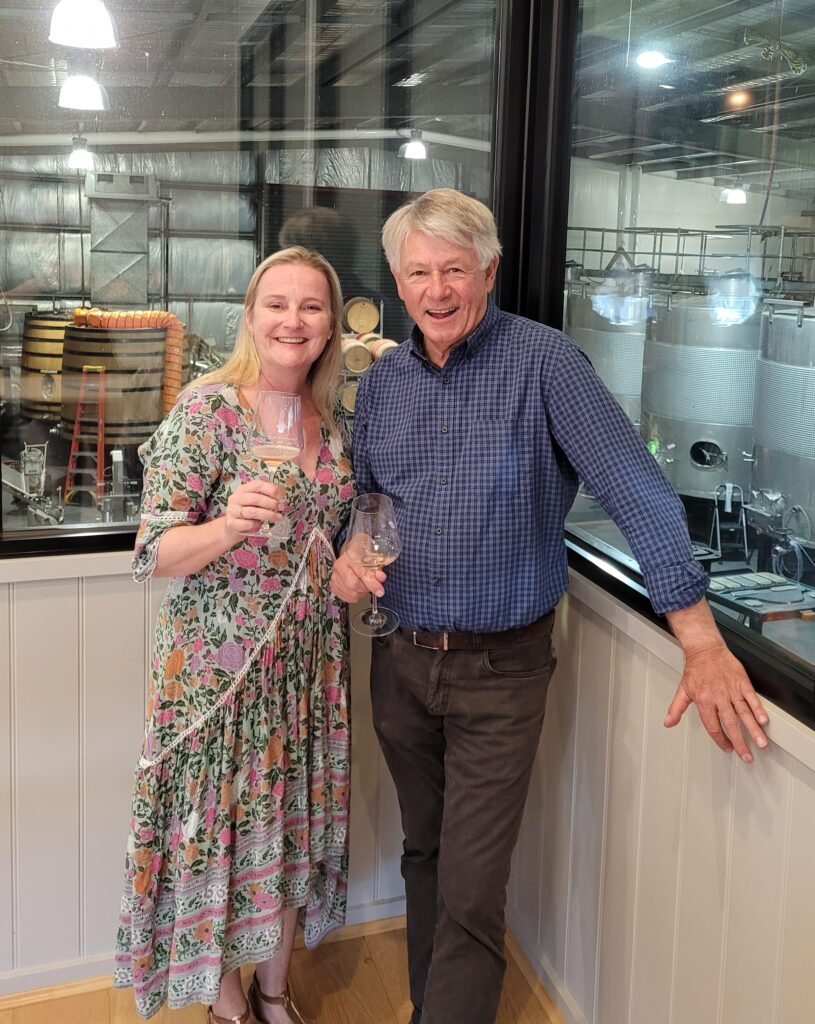
These are the sparklings that I tasted on my visit:
2015 Dominique Portet Blanc de Blancs
100% Chardonnay.
Fruit for this sparkling wine comes from the same vineyard used for their highly-awarded Origine Chardonnay – a mature site in the Upper Yarra Valley with volcanic red soils on a steep, fast-draining slope at a relatively high altitude of 250m. The elevation makes for cooler growing environment, and picked early (mid-February) to seek acidity while the grapes are still green and bright. 2016 was a stunning vintage – mild and dry – and perfect for Chardonnay and sparkling production.
Hand-picked when the fruit showed plenty of acidity in the green apple and lime spectrum. Whole bunches were pressed using a traditional Champagne cycle – very gently to retain optimum freshness. Fermentation took place in tank and left on lees for 6 months prior to tirage in bottle. Made Methode Traditionelle, the wine is aged in bottle for 3 years before being disgorged and then aged a further 12 months to allow the wine to come together. Dosage is a low 4g/L to ensure fruit purity retention and give a crisp, mouth-watering, energetic style of sparkling.
Palest yellow colour with a fine bead. It’s fresh and lithe, lemon rind leads the bouquet, the faintest hint of brioche, vanilla, praline, and grapefruit. Delightful when sipped, piercing, pristine fruit, green apple acidity. A wine of great length and continued promise.
Dominique Portet NV Brut Rosé
Pinot Noir, Chardonnay.
The grapes for this Methode Traditionelle sparkling came from two elevated vineyards (250m) in the Upper Yarra. The grapes were hand-picked, gently pressed, and fermented before going through secondary fermentation in bottle. The wine was then aged for two years in cool, temperature-controlled cellars, then disgorged and given a light dosage prior to release.
2006 Dominique Portet Cuveé Tasmania
Pinot Noir, Chardonnay.
Paying homage to his time in Tasmania, this special release Methode Traditionelle sparkling made in Tasmania is only available at the Cellar Door.
Rochford Estate
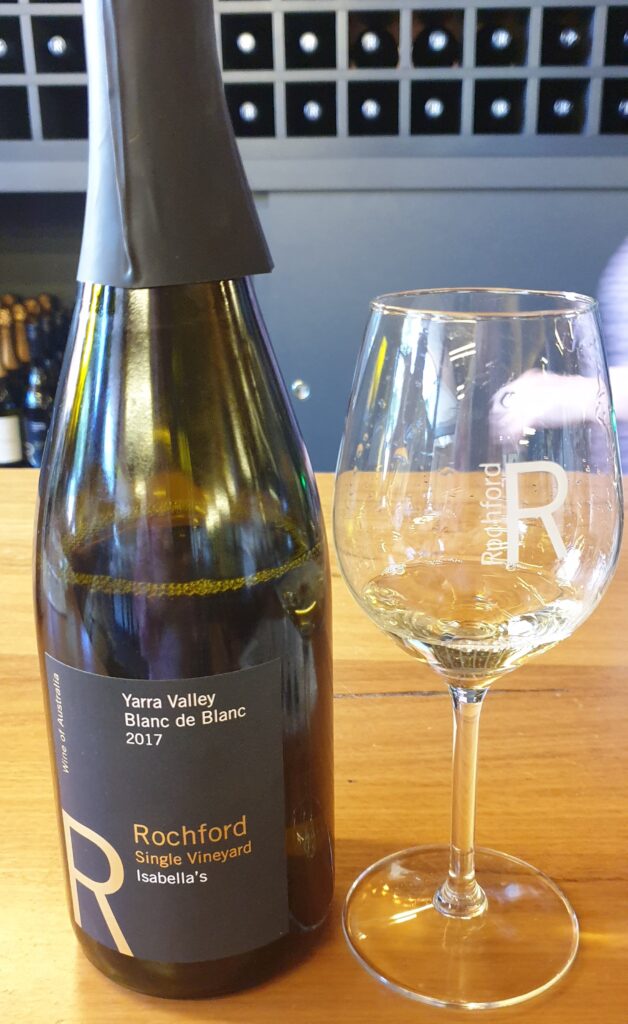
Rochford Wines begins with owner and CEO Helmut Konecsny, who has always been the driving force behind this dynamic wine business since first purchasing the land in 2002. A family business at heart, Helmut’s passion for Yarra Valley wine, great food, service, and entertainment has seen Rochford expand exponentially over the years.
After many years in the corporate world in Australia and overseas, Helmut purchased a vineyard in Macedon Ranges where the concept for Rochford Wines first began. While still commuting to his corporate obligations and managing the vineyard, the opportunity to purchase ‘Eyton on the Yarra’ came to Helmut’s attention. With its old vine plantings, proximity to Melbourne and highway frontage, the potential to develop the site into something truly special was immediately apparent. And so, Rochford Wines of the Yarra Valley was born.
Now producing award-winning wines, Rochford encompasses three vineyard sites, two restaurants, a wedding and functions venue, and a huge 12,000 capacity outdoor concert amphitheatre that hosts the popular concert series – A Day on the Green – amongst other headlining acts. The dreams Helmut had for Rochford Wines are being realised – to create a place that captivates the senses and provides memorable experiences for all who visit.
Nestled in the hub of Rochford, the Cellar Door is a celebration of vineyard and winery combined. “Explore and learn about the grapes we grow, the wine we craft and the legacy we are building for the future.”
With a range of tasting options designed to explore their extensive collection of wines, and facilities to cater for a range of needs, the Cellar Door is a favourite for local and international groups visiting the area. The ethos is to produce sparkling wines with personality that are true to the vineyard site and the weather patterns that have shaped it. I tasted four sparklings on my visit.
Rochford Single Vineyard Isabella’s Blanc de Blanc 2017
100% Chardonnay.
Hand-picked on 10th February 2017, gently whole bunch pressed according to time-honoured Methode Traditionelle to retain crisp acidity. The first fermentation is done in temperature-controlled stainless steel fermentation vessels and inoculated with specialist yeast for sparkling wine. Secondary fermented in the bottle and aged on lees for at least 18 months. The aromas are jasmine, preserved lemon and sea-spray/saline. Lively on the palate where the mousse flows freely. Flavours are led by lemon and lime yet finish with a pleasing maritime brine.
Rochford Single Vineyard Isabella’s Blanc de Blanc 2018
100% Chardonnay.
This 2018 Blanc de Blanc sparkling was made entirely from their single vineyard estate-grown chardonnay. After tank fermentation and assemblage, the second fermentation is Methode Traditionelle. Aged on lees for a least 2 years. The colour is medium to pale yellow straw. Mineral aromas of wet slate blossom to lemon sours, citrus burst, and sherbet tones. An evolution on the palate of immediate presence of wholemeal toasted muffins and lemon butter, which broadens to mouth-filling texture on the middle palate. The palate then tightens to fine, crisp but juicy acid on the finish with a delicate dry tannin aftertaste.
Rochford Single Vineyard Swallowfield Sparkling Rosé 2018
100% Pinot Noir.
Swallowfield is in Gembrook, making it the southernmost vineyard in the Yarra Valley, with its rich quartz soil making it ideal for Pinot Noir. This is the second vintage rosé from this vineyard, the 2018 harvest being known for great yields and quality fruit. Lifted nose of strawberry top, spiced clove, and yeasty notes of cinnamon bun. The palate has gentle sweetness of wild berries and stone fruit with a pillowy soft texture, yet also has an incisiveness to its acid line that gives that refreshment factor.
Rochford Prosecco NV
87% Glera 87%, 13% Chardonnay.
Charmat method. Australian Prosecco is a vibrant sparkling wine style, and this wine displays the colour of pale straw with lime hues. The nose is floral and crisp green apple. These aromas lead to a palate brimming with apple, hints of honeydew and pink grapefruit notes with a zesty finish.
Levantine Hill
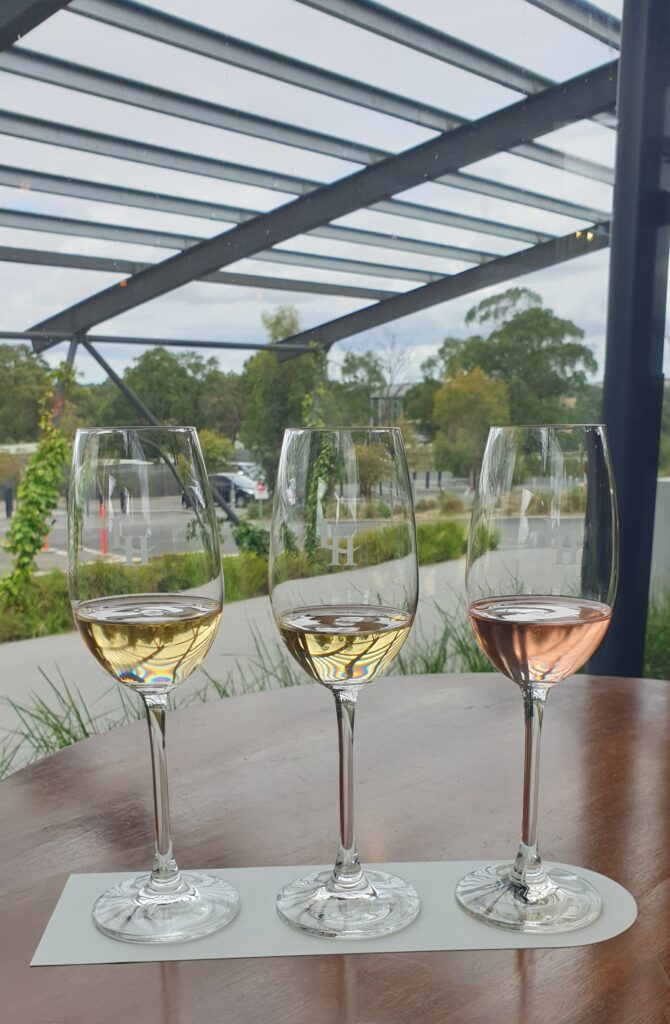
Levantine Hill is the perfect merger of two vineyards in the heart of the Yarra Valley. On one side, a vineyard producing superior grapes since the 1990s. On the other, lovingly planted family blocks alongside a truffiére surrounding the family’s homestead. Together, this combined estate is pure testament to the passion and toil of dedicated human hands, and man’s tenuous relationship with the nurturing love of Mother Nature.
It all began against the odds. The piece of the Yarra Valley they chose for their first vineyard was a hill that the experts told them was far too steep and had too many underlying rocky outcrops, making it impossible to plant viable vines. Not to be deterred, the family saw what was possible. The location was incredible, the soil profile was perfect. So, with unwavering determination, and the use of a diamond-tipped drilling rig to remove the rocks, Levantine Hill began to take shape. Today, that impossible hill is the family vineyard, which has the ethos that they will only ever bottle premium wines in impeccable years. Rising from the shores of the Yarra River at 75 metres and peaking at 225 meters above sea level, Levantine Hill vines thrive in looking out over steep clay loam slopes, at similar elevations to the Grand Cru vineyards of Chablis, France.
Everything about this vineyard and Cellar Door experience sings quality. The architecture and interiors are opulent, the landscaped grounds are an open-air gallery displaying sculptures and paintings, an expansive lawn area is home to the Chairman’s helipad, you can arrive from the heliport in Melbourne’s CBD in the ‘Levantine Hill’ badged helicopter for the ultimate Cellar Door and restaurant experience.
There is bar-style seating in the Cellar Door for tastings with views and vistas over the vineyards and sculpture gardens. If dining, you can also include a tasting flight as part of your experience, and there is an inner circle room for private tastings for 2–12 people, and some amazing Chairman’s experiences available combining the heliflight.
I arrived by road with my designated driver, which is also an impressive arrival experience. Each of the Levantine Hill sparklings are premium wines from vintages to showcase impeccable years. On my visit I did the seated Cellar Door sparkling tasting flight of three sparklings. The tasting notes for each wine are on a separate card, with the wine notes on the front and a suggested food pairing and recipe on the back.
2012 Méthode Traditionelle Sparkling
53% Chardonnay, 47% Pinot Noir.
The 2012 vintage is known as one of the finest in the Yarra Valley for that decade. The ideal conditions presented the opportunity for Levantine Hill to follow-up its inaugural 2010 sparkling Méthode Traditionnelle with a similar blend from an almost mirror image vintage. The intention was to allow this cuvee to age for a period of 5 years on lees to further enhance its intensity and breadth of expression – displaying a freshness and vitality of bead and mousse that defy its extended ageing. This traditional method sparkling wine from a multitude of blended components features aromas of cider apples, citrus, rockmelon, white flowers, and frangipani tart. The Pinot Noir elements come to the fore on the palate adding richness and width to the saline and oyster shell line of the Chardonnay. The extended ageing on lees has conferred weight and texture with crème anglais richness. Beautifully balanced acidity, honey suckle, biscuit with lovely length and bead. There is now a late disgorged version of this sparkling available, and we’re also awaiting the next vintage release.
2013 Sparkling Blanc de Blanc
100% Chardonnay.
The protracted growing season allowed a drawn-out ripening, resulting in an uncommon richness of flavour tempered by the abundant natural acidity contributed by the season.
A bouquet of nashi pear-glazed brioche, lemon cheesecake, and amaretti biscuit. Flavours of nougat, lemon rind, jasmine and chestnut underpin a palate line of steely acidity with delicate bubble, fruit weight in the mid-palate of peach and earthy ‘on lees’ characters providing textural accompaniment, richness, and creaminess to the finish. Delightfully delicate on the palate, an excellent match for freshly shucked oysters or semi-hard cow’s milk cheeses. Since my visit, the 2018 vintage has been released.
2015 Sparkling Rosé
100% Pinot Noir.
2015 was even better and is widely hailed as the greatest Yarra Valley vintage of the decade. This presented the opportunity for Levantine Hill to follow-up the inaugural 2014 Sparkling Rosé, following the appointment of winemaker Paul Bridgeman in 2013. This led to the creation of a finite quantity of single vineyard Sparkling Rosé. Displaying a fineness and vitality of bead that defies its extended ageing, this 2015 traditional method Sparkling Rosé is produced using the ‘saignee’ method (meaning to bleed in French), and it has had gentle skin contact to create the rose colour. This bringing with it an earthy nose with a hint of tannins, with aromas of brioche, strawberry danish, saltbush, rose petal, finger lime, and nutmeg undertones. The Pinot Noir announces its presence on the palate as richness and bandwidth. The extended ageing on lees has enhanced body and crème anglaise texture over a saline acid backbone with blood orange, cranberry, tarragon, and Campari-like flavours carrying through and prolonging the finish with lovely long length. The food pairing card suggests Blinis with Caviar, Smoked Salmon, and Finger Lime Crème Fraiche. Since my visit, the 2016 vintage of this sparkling has been released.
Coombe Yarra Valley
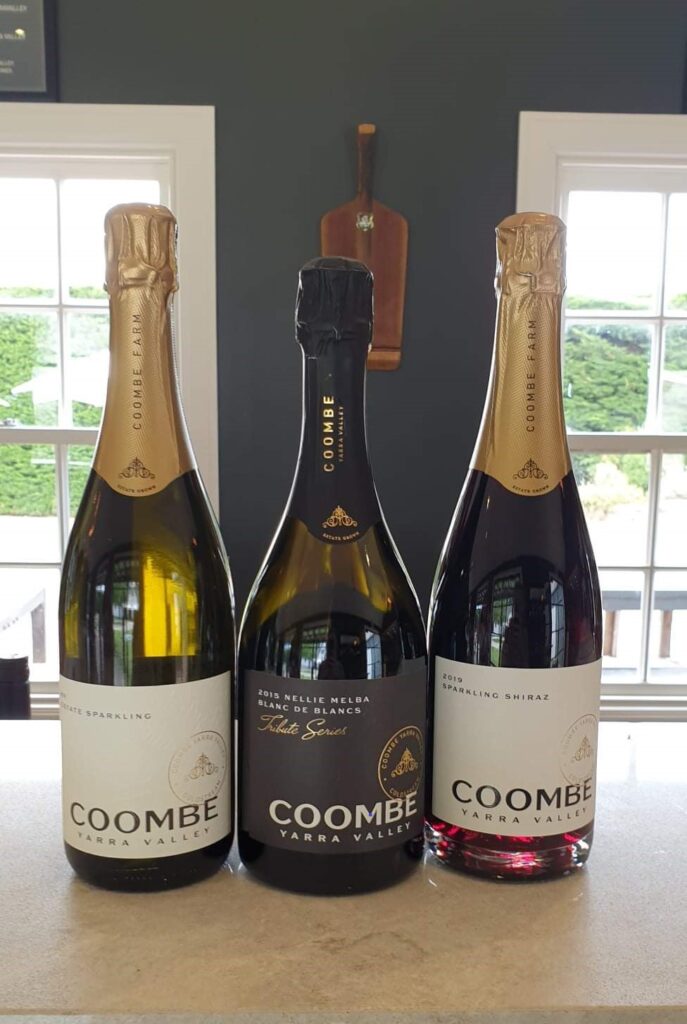
Once the home of the world-famous opera singer Dame Nellie Melba, Coombe Yarra Valley is a unique gourmet and cultural destination. Situated among seven acres of stunning gardens, visitors are treated to a world-class dining experience featuring award-winning Coombe Farm wines, against a historic, picturesque backdrop.
Located on seven acres at Coldstream, the property (established in 1909), really is the gateway to the Yarra Valley situated where the roads split to become the Melba and Maroondah Highways. A beautiful a la carte restaurant in the restored motor house and historic clock tower on the estate are destinations to dine and a popular location to celebrate weddings and private events.
The Cellar Door provides tastings of their estate-grown wines. Food options include platters to enjoy with wine or gin on the garden terrace. You can even take a glimpse into Melba’s extravagant life on a guided tour of Coombe Cottage, or the stunning 100-year-old gardens surrounded by 600m of Cyprus hedges.
The Coombe Farm Vineyards are in the heart of the Yarra Valley. Just 5km north of the Melba Estate, the 120-acre Coombe Farm vineyard is one of the oldest in the valley, and is still owned and operated by Melba’s descendants, the Vestey family. The soils are well-suited to vines growing premium cool climate grapes. Having supplied grapes to some of Australia’s most recognised producers, an increasing portion of fruit is now being grown and selected specifically for Coombe Yarra Valley Wines.
I’ve dined in the restaurant here on several occasions, and it was a lunch stop on this trip. The food and service were both wonderful. I tasted three sparklings at the Cellar Door before moving to our reserved table in the restaurant. ‘Dining like a diva’ was my social media caption for the day, and I love a great historical story to accompany good food and wine, and this place ticks all the boxes.
Coombe NV Estate Sparkling
50% Chardonnay, 50% Pinot Noir.
Premium estate-grown Chardonnay and Pinot Noir parcels were pressed and fermented separately at cool temperatures to retain their delicate aromatics. For the first fermentation, a portion of each was fermented in one year old French Oak to introduce complexity and weight to the blend, with the balance produced in stainless steel tanks. Secondary fermentation occurred in tank (Charmat method) and the final wine was bottled under pressure. It’s a bright and lively sparkling with aromas of citrus and white acacia and a full balanced palate of golden apples, macadamia, and hints of toasty brioche. A gentle, creamy mousse leads to a long finish. Suggested food pairing with toasted brioche, lobster, watercress and creamy aioli.
2015 Tribute Nellie Melba Blanc de Blancs
100% Chardonnay.
The acclaimed Blanc de Blancs is Methode Traditionelle from estate-grown Chardonnay. The Tribute Series represents our finest, single site expressions. Aged on lees for 4 years before release, dosage in the Extra Brut range of 6g/L, allowing the wine to maintain the fresh, dry style you expect from a quality Blanc de Blancs. This Nellie Melba Blanc de Blancs is distinctly Yarra Valley, with delicate hints of citrus, chalk, and spice scented flowers. The palate is vibrant, fresh, and lifted, with notes of tangy grapefruit and melon and a seamless, persistent bead. There is a fullness in the mouth, with a hint of creamy brioche and pristine lemon acidity. Suggested food pairing is freshly shucked oysters, with green apple mignonette and cucumber wasabi granita.
NV Estate Sparkling Shiraz
100% Shiraz.
I tasted the 2019 vintage on my visit. The sparkling shiraz is now a non-vintage using the 2019 as a reserve wine and bringing in later vintages. Subtle aromatics of plum dark cherries, warm toffee, purple plums, sawn oak with a lift of raspberry. A medium-weighted palate being bright rather than brooding. A pop of cherry and ripe raspberry, Christmas spice with a touch of marzipan, all flowing into a balanced finish of sweet fruit, dosage, and bead. Suggested food pairing is breakfast(!) – Spanish baked eggs, on chorizo, red pepper and beans, tomato, paprika and baby spinach.
YARRA GLEN to HEALESVILLE
Vineyards in this area encompasses the sub region surrounding the small country towns of Yarra Glen and Healesville.
Greenstone Vineyards
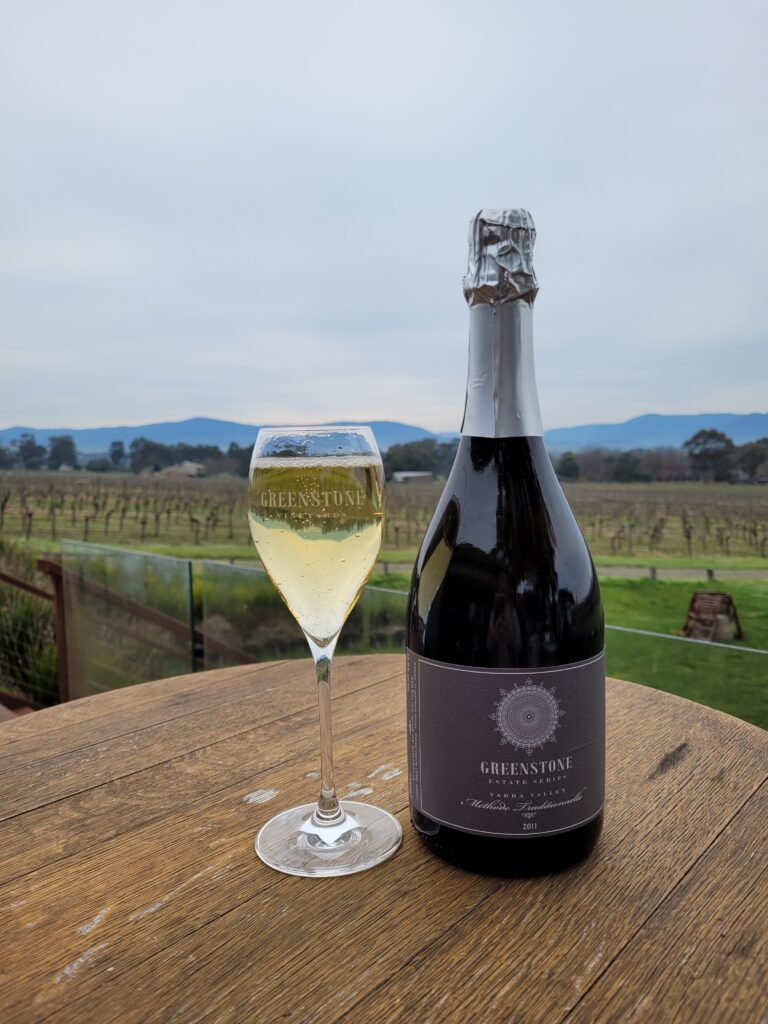
On the edge of the town of Yarra Glen at the base of the Christmas Hills, this Cellar Door is like a unique local secret that you might only know about it if you know someone who knows, or of course are a follower of The Bubbles Review! The winery has an interesting history and the winemaking facilities are big for a small Cellar Door. The reason for this is that Greenstone Vineyards was established in Heathcote in 2003 by global industry leaders David Gleave MW (Liberty Wines UK), Alberto Antonini (Poggiotondo) and renowned Australian viticulturist Mark Walpole. With a change of ownership in early 2015 to the Melbourne Jiang family, the success of Greenstone’s Heathcote wines led the team to explore opportunities and expand their repertoire.
The requirement to find the best locations for each varietal led the search to the Yarra Valley and acquisition of the Sticks Winery and vineyards, which was originally established as Yarra Ridge in 1983 by Melbourne Lawyer Louis Bialkower (a close friend and colleague of Australian wine legend James Halliday who assisted in the planting of the vineyard). On 33 hectares, the vineyard quickly gained recognition as a prime site for Chardonnay, Pinot Noir and Cabernet Sauvignon. Today, this is the home of the Cellar Door and Winery of Greenstone Vineyards.
“We take a sustainable approach to grape-growing, respecting and protecting these ancient sites”.
I met with John, the Cellar Door Manager, who showed me through the winemaking facilities and provided the tasting at Cellar Door. The Cellar Door has a simple rustic feel, with large windows looking out over the deck that looks over the vineyard undulating down to the Yarra Valley and Ranges beyond. A simple blackboard menu of platters, gourmet pies and sausage rolls is available. They also cater for private tastings and events.
Greenstone Estate Series 2011 Méthode Traditionelle
54% Pinot Noir, 46% Chardonnay.
Hand-picked and whole cluster pressed, the pristine juice was cold settled overnight. The Pinot Noir was racked together, while the Chardonnay stood alone. The first fermentation was done separately, with a very small portion (15%) in 5-year-old French hogshead oak vessels to provide complexity.
Aged on lees in tank and oak until tirage (into bottle for second fermentation) in November 2012, it was then aged in bottle on lees for 4 years.
Aromas provide a hint of oak and honeysuckle, the palate gives flavours of crunchy apple, pear, citrus, oyster shell, the fine mousse finishes with a creamy elegance.
NV Gusto Frizzante
Chardonnay, Pinot Grigio, Pinot Noir and a dash of Sauvignon Blanc.
From their Gusto range, frizzante means fizzy, and usually indicates a gentle fizz with light bubbles. It’s an easy drinking style, perfect for relaxed summer days. For this interesting blend, grapes were chosen from vineyard and sites for best for each varietal including King Valley, Mornington Peninsula, and their own Estate Yarra Valley vineyard.
Picked in the early morning to ensure freshness, fruit is pressed into tank upon arrival at the winery. The clean juice then undertook co-fermentation of Chardonnay and Pinot Grigio in stainless steel and left on lees to build texture and complexity. An addition of Pinot Noir added for structure and complexity with a dash of Sauvignon Blanc to liven the aromatics. 7g/L of dosage added to balance the natural acidity. A light carbonation creates a textural, light easy drinking sparkle on the palate.
A bit of pear and crisp green apple on the nose. On the palate expect a soft mouthfeel bursting with flavours of quince, pear, and citrus.
Their serving suggestion is best served chilled and with friends! We think fresh oysters, any manner of seafood or, if that’s not your thing, just drink it by itself – you’ll love it!
2016 Port Phillip Sparkling
Chardonnay, Pinot Gris, Pinot Noir.
This one is only available at Cellar Door. It’s a bit of a cleanskin style label with a blend of Upper Yarra Chardonnay, and Pinot Noir and Pinot Gris from the Mornington Peninsula. It’s spent 18 months on lees in the first fermentation, and then the carbonation method used for creating the bubbles. It still in the brut range with a dosage of 11g/L. Aromas of sweet citrus blossom and cranberry. On the palate it tastes as medium to dry, with fruit tingle, apple, pears, pink grapefruit, and blood orange characters bursting then leaving the palate with savoury after taste. It’s a popular, fun, easy drinking bubbly and a great one for wine cocktails.
TarraWarra Estate
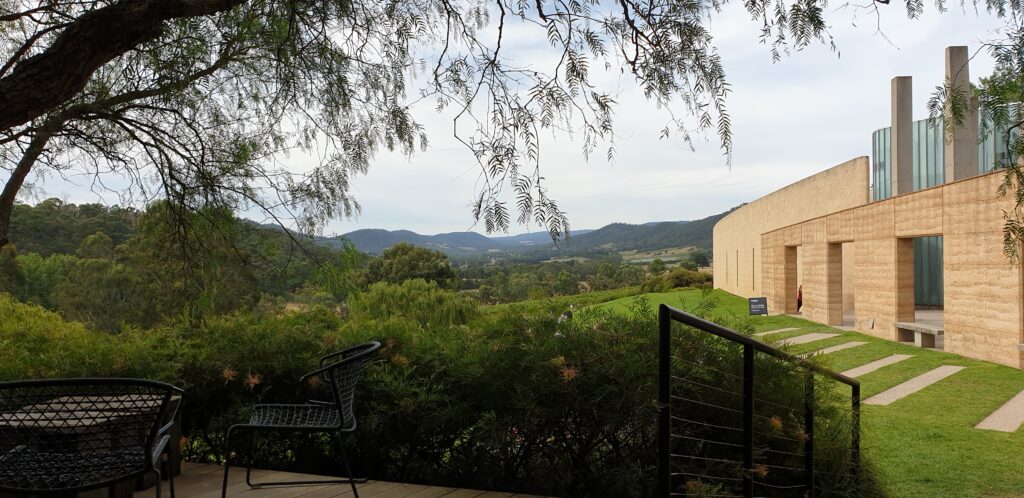
‘Tarrawarra’ is a Woiwurrung word that translates approximately as ‘slow moving water’, and is the name given to the area within the Yarra Valley in which the Cellar Door is located.
Founders Marc and Eva Besen purchased the property at TarraWarra in 1979, initially as a family retreat. Thanks to their love of the wines of Burgundy, and with encouragement from legendary Yarra Valley winemaker Dr John Middleton, they planted the first six hectares of Chardonnay and Pinot Noir in 1983. Forty years on, the 400-hectare property now encompasses 28 hectares of vines, an extensive nature reserve, cattle grazing, a kitchen garden and our beautiful Cellar Door and restaurant. The vision to create and share a unique and beautiful place is driven by gratitude to this country that opened its arms and homes when Marc Besen arrived in 1947. The team here say they continue to strive to fulfill his vision for TarraWarra, as custodians, defined by heritage and a deep sense of place.
TarraWarra Estate’s respect for sustainability and provenance make the property an internationally recognised place to visit in the Yarra Valley. The subterranean Cellar Door makes for an unforgettable tasting experience, while the deck – shaded by native peppercorn trees – and with expansive views of our surrounds, is the perfect place to linger over a glass of wine. The restaurant is a special dining experience with a menu inspired by their kitchen garden and local produce. Outdoor casual dining is sometimes available with food provided by visiting food trucks.
You could easily spend a few hours here as located on the property is the TarraWarra Museum of Art. Since opening its doors to the public in 2003, it has been one of the cultural jewels in the Yarra Valley, providing visitors with a relaxing and enjoyable experience comprising of stunning architecture and a diverse program of exhibitions and events. The Museum of Art captures the vision of its founders, not only wine lovers, but they are also philanthropists and passionate collectors of Australian art from the 1950s to the present day. Not only did they gift the building that houses the Museum, but also a significant portion of their collection of modern and contemporary Australian art for the enjoyment of all visitors.
There was one sparkling on tasting during my visit.
2010 Sparkling Blanc de Blancs
2010 was one of the most ideal vintages, with mild to warm weather throughout the season. This sparkling is made from a single block at TarraWarra, hand-picked, whole bunch pressed, with a long, cool tank ferment. Made Methode Traditionelle the wine has spent 8 years on lees in bottle before disgorging in December 2018. Toasty bread aroma, the palate is very fine with a lovely creaminess. The line of acid gives way to a wonderful persistence of flavour.
Boat O’Craigo
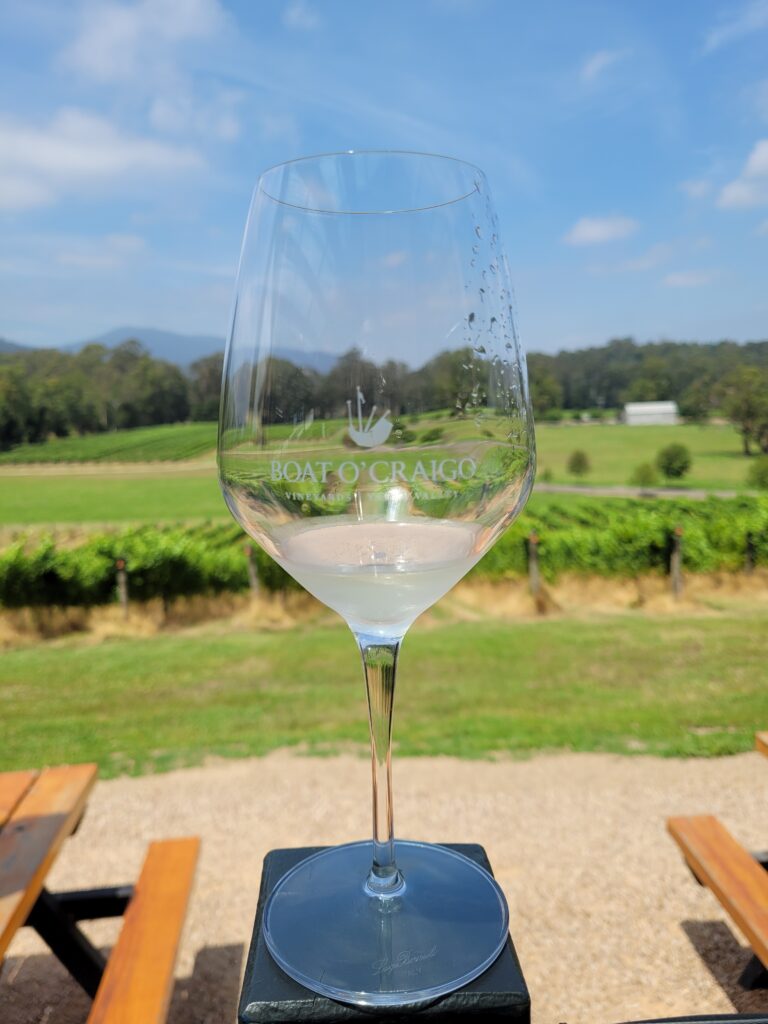
50 acres of vines, spanning across two stunning sites, enables Boat O’Craigo to produce estate grown wines across a range of noble varieties. The interesting name comes from Scottish heritage and the same name given to an ancestral family farm located in the town of Craigo near the docking point for the ferry (boat) that crossed the North Esk River.
Years later, the Graham family, with a successful road construction, pursued their love of wine by establishing themselves in the wine business in the late 1990s with the purchase of a unique property at Kangaroo Ground on an extinct volcano. They purchased a second equally unique vineyard in Healesville in 2003, which was the original Graceburn Estate site, with a view to growing and developing the Boat O’Craigo name and offerings. They extended their range and established the Cellar Door here at the foothills of the Black Spur Ranges and bound by the Graceburn Creek. This stunning site was ideal for producing the cooler climate varietals of Chardonnay, Sauvignon Blanc, Pinot Gris, and Pinot Noir.
The Cellar Door has enormous floor to ceiling windows and an outside deck that takes in the vineyard and rolling hills beyond.
The friendly and knowledgeable staff provide guided wine tastings and there is a wide range of premium estate-grown boutique wines available by glass and bottle. They produce two Méthode Traditionelle sparklings, one of which is a sparkling shiraz. Food is antipasto, pizzas, and salads. Good quality ingredients and works well to share with a table of friends or family. I visited during the summer holidays and enjoyed a lovely lunch sitting up on high tables on the deck with a great view of the vineyard and ranges. There is abundant birdlife, and the occasional kangaroo hopping by, and the staff told me that you might even be lucky enough to see wild deer or an echidna.
2020 Sparkling – Méthode Traditionelle
55% Chardonnay, 45% Pinot Noir.
This single vineyard Sparkling Méthode Traditionelle was hand-crafted from selected clones of Chardonnay and Pinot Noir from the Healesville vineyard. The wine displays elegance and finesse typical of cool climate sparkling. An alluring bouquet of brioche, fresh dough and citrus blossom give way to peach and fresh nectarine on the palate, amplified by an extended period on lees.
2021 Sparkling Shiraz
100% Shiraz.
The original family vineyard at Kangaroo Ground is one of the highest sites in the Yarra Valley and is home to their renowned Black Cameron Shiraz. Taking inspiration from the success and reputation of the Black Cameron Shiraz, the release of the 2021 maiden vintage of Sparkling Shiraz is one they anticipated for many years.
It’s Methode Traditionelle, producing a rich and elegant Sparkling Shiraz. Deep red in colour, with a fine bead that dances in the mouth, and alluring aromas of blackberry, cherry, and spice. It’s only 6g/L of dosage, but gave a bit of sweet berry fruit in the mid-palate and finished dry with a bit of peppery spice.
Upper Yarra Valley
A sub region above the Yarra Valley where the climate is known to be cooler.
Seville Estate
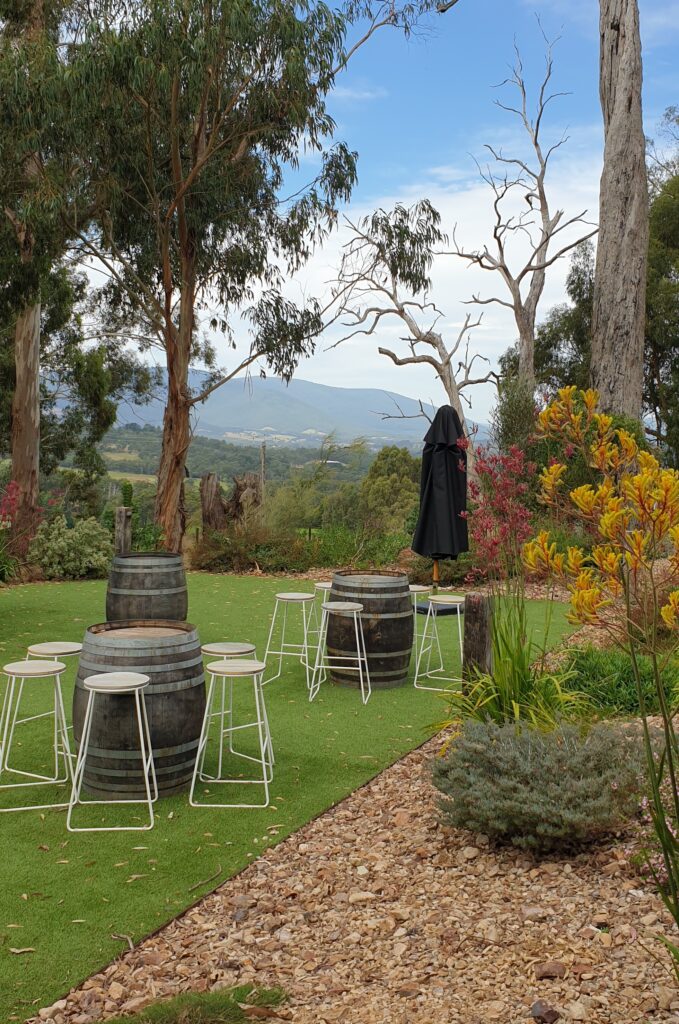
Dr Peter McMahon planted the first vines at Seville Estate in Victoria’s Yarra Valley in 1972. At the time others planted in more proven grounds, he chose to call the Upper Yarra home, where he said the climate is cooler and the soil holds the potential to craft wines that inspire us to explore, experiment and excite.
Today, Dr McMahon’s legacy lives on at Seville Estate. His Grandson, Dylan McMahon, is the winemaker. Dylan was on track to become an electronic engineer until he decided to follow his destiny and make wine. “Our philosophy at Seville Estate is to capture the fruit expression of this unique vineyard, in wine styles that show cool climate complexity and finesse”.
They won the Halliday Winery of the Year Award in 2019. The Cellar Door is set amongst a native garden, high on the ridge of the Upper Yarra Valley with stunning views overlooking the vineyard and beyond. There are lovely outdoor seating areas perfect for enjoying the wines and surrounds. If you’re planning on a mid-week visit, you’ll need to make a booking as the Cellar Door is open by appointment from Monday–Friday. Saturdays you can arrive without needing to book.
I stayed overnight here and there are a couple of accommodation options.
There is the lovingly restored Seville Homestead, built by Dr Peter McMahon and his wife Margret in 1975. The homestead offers a place to unwind and celebrate family and friends in a stunning contemporary space overlooking the pool area, native gardens, and the distant hills to the west. The homestead features four bedrooms and can accommodate up to eight people.
I stayed in the Vineyard Apartments. Three newly renovated and uniquely styled self-contained apartments that are perfect for couples. Each room features a king bed, ensuite bathroom, a kitchen, and a private balcony. There’s also a wine fridge with Seville Estate wines by the bottle to purchase. Our room looked out over the vineyard and dam. The morning sunrise over the vineyard and watching the ducks waddle around the dam was a lovely way to wake up.
They make a vintage sparkling, and we enjoyed this in our apartment.
Seville Estate 2018 Blanc de Blancs
100% Chardonnay.
Fruit is hand-picked and whole bunch pressed. First fermentation aged on lees for 12 months before Methode Traditionelle for second fermentation in bottle aged for another 32 months. It is a ‘brut nature’ with zero dosage. The closure for this wine is a crown seal and it will age gracefully. Aromas of bright lifted fruits of melon and grapefruit. Toasted nutty aromas are well integrated with the creaminess from the lees contact. The palate shows fresh melon fruits that evolve into a complex palate with toasty notes of spice, nuts, and citrus. The mouthfeel is a lovely fine bead that finishes dry with great acidity and length.
Meletos
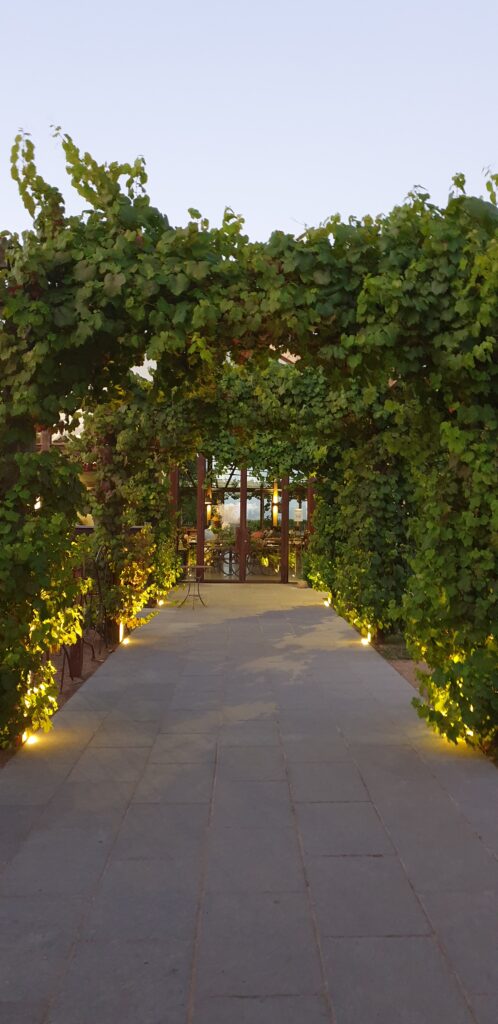
If you’re overnighting midweek in the Yarra Valley it can be tricky to find restaurants open. A quick mention for Meletos – not a Cellar Door but restaurant in Coldstream. They open for dinner 7 nights a week and lunch a few days a week. They usually have some nice Yarra Valley sparkling on their wine list. I’ve dined here many times. The menu highlights local produce, they have professional friendly staff, and the cafe style restaurant is a lovely rustic style. See website here.
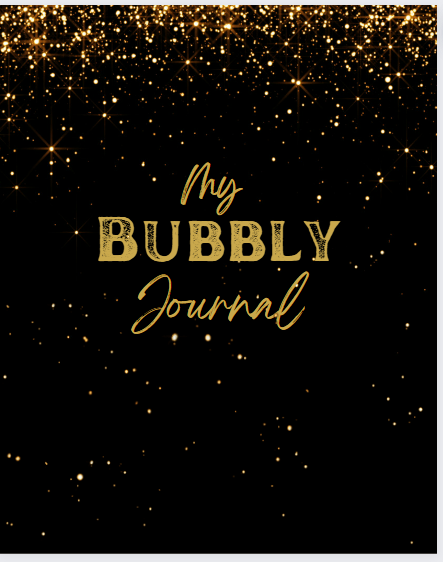
My Bubbly Journal is the perfect companion for your Sparkling Cellar Door visits! It has tips on tasting techniques and our favourite TBR bubbly quotes. It’s a journal for notes, for planning events and tours, keeping notes on your tastings, cellar door visits, bubbly food matches and there is a bubbly wish list as well! See our shop page to purchase.
Like to keep following us, get first look at events, receive bubbly information and be in our giveaway draws and have a chance to win a bubbly prize? You can join our list, it’s FREE to join here.
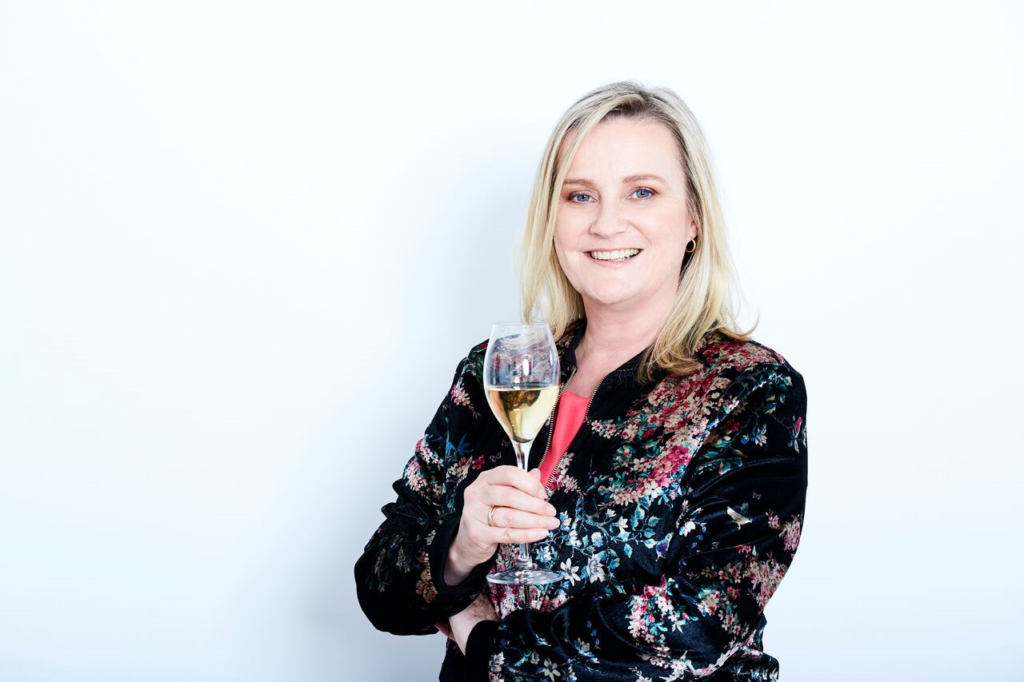
Natalie Pickett is the Founder of The Bubbles Review which is for people who like champagne and other bubbles, written by people who have a love of all things sparkling! At The Bubbles Review, we like to debunk some myths, make the art of drinking champagne accessible, explore bubbly regions and champagne bars, and provide events for you to join us and indulge.
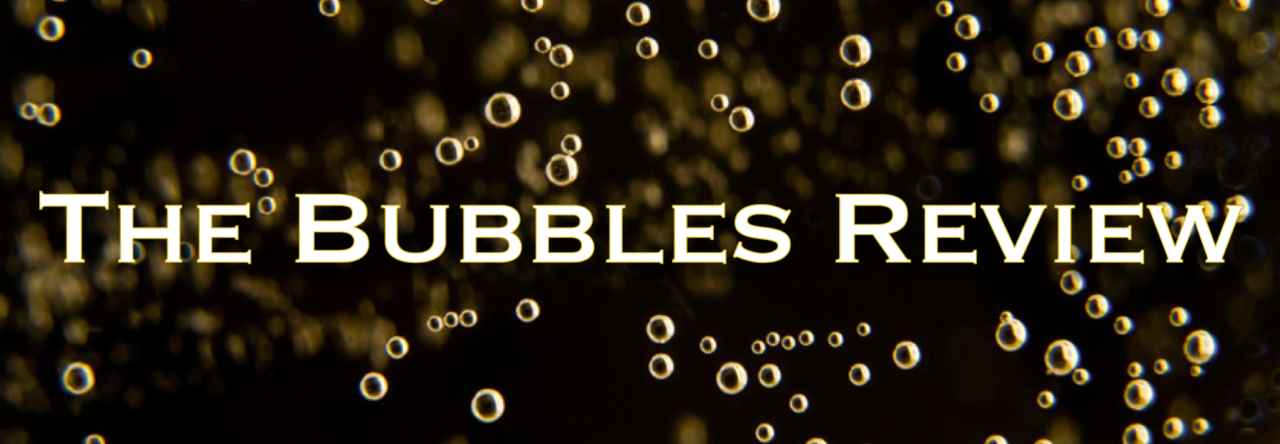
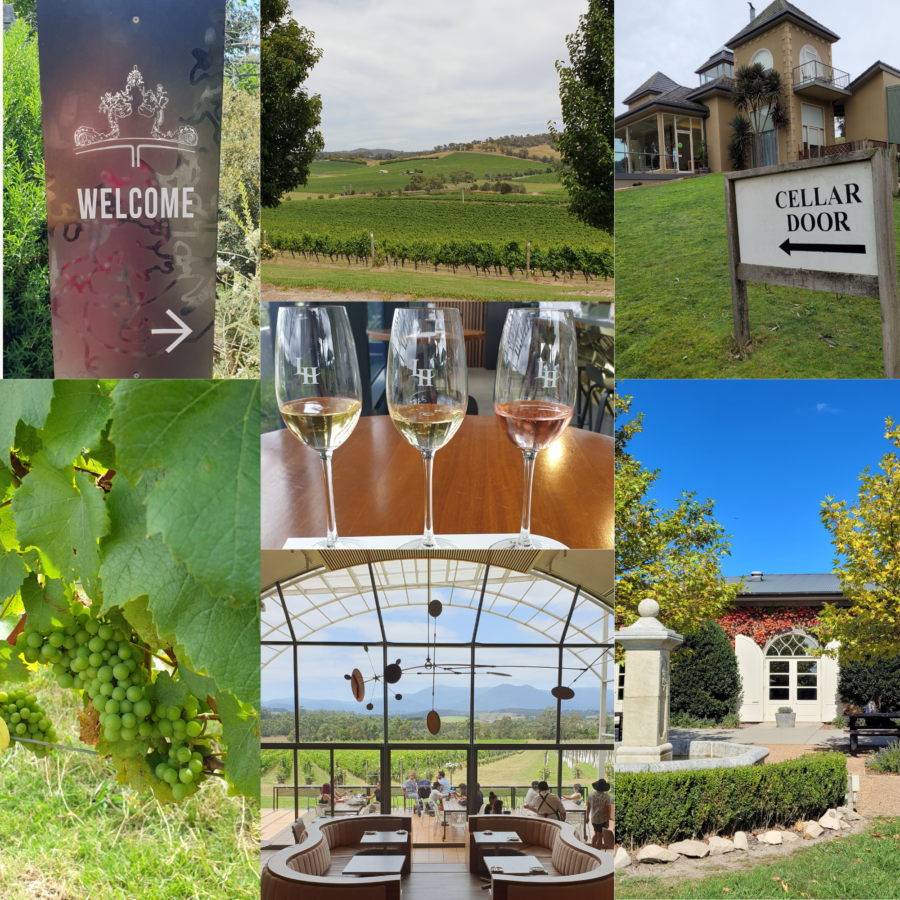
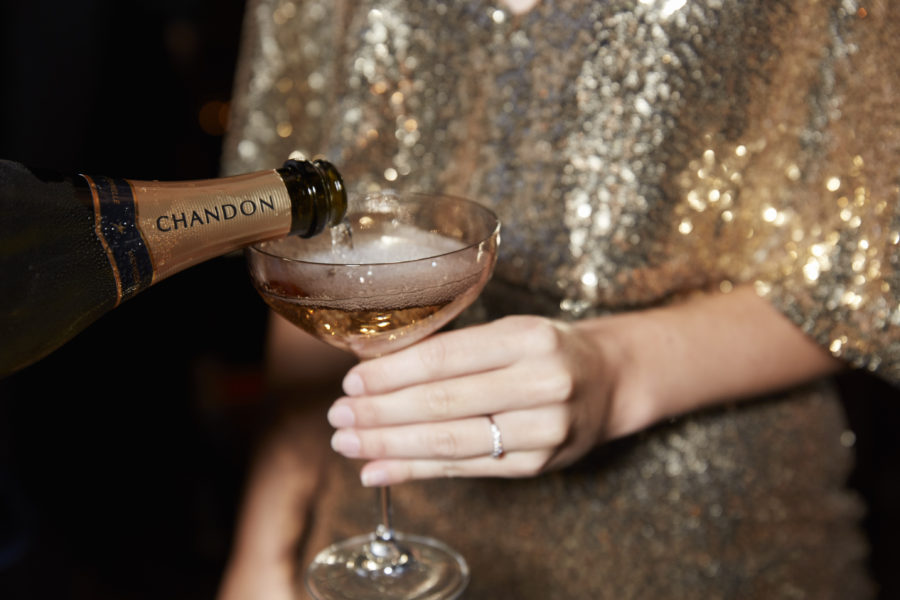
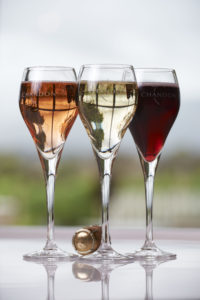 not constrained to using the same cuvee and tailles juice fractions, which are mandatory in Champagne. We are able to use viticultural practices more suited to our local environment. We can even machine harvest in the cold of night, and we can even make sparkling Pinot noir/Shiraz! The pioneering spirit in Australian winemaking is still very much alive.
not constrained to using the same cuvee and tailles juice fractions, which are mandatory in Champagne. We are able to use viticultural practices more suited to our local environment. We can even machine harvest in the cold of night, and we can even make sparkling Pinot noir/Shiraz! The pioneering spirit in Australian winemaking is still very much alive.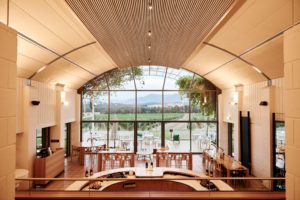 French heritage, Australian expertise – Chandon is a celebration of its traditional French heritage and the know-how enjoyed in its Australian homeland. Moët & Chandon meets Australia in a world-class winery in the Yarra Valley. Chandon was honoured with international success at the 2016 Champagne and Sparkling Wine World Championships, taking out the national trophy for Best Australian Sparkling Wine for the Chandon Prestige Cuvée 2005. It’s a beautiful place to visit and enjoy a tasting at the Cellar Door. Details here
French heritage, Australian expertise – Chandon is a celebration of its traditional French heritage and the know-how enjoyed in its Australian homeland. Moët & Chandon meets Australia in a world-class winery in the Yarra Valley. Chandon was honoured with international success at the 2016 Champagne and Sparkling Wine World Championships, taking out the national trophy for Best Australian Sparkling Wine for the Chandon Prestige Cuvée 2005. It’s a beautiful place to visit and enjoy a tasting at the Cellar Door. Details here